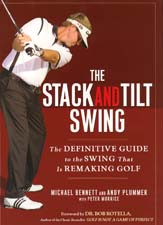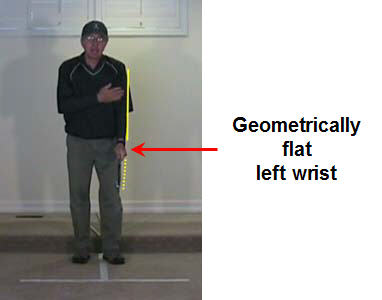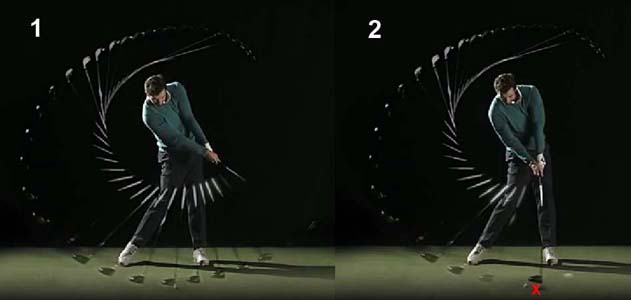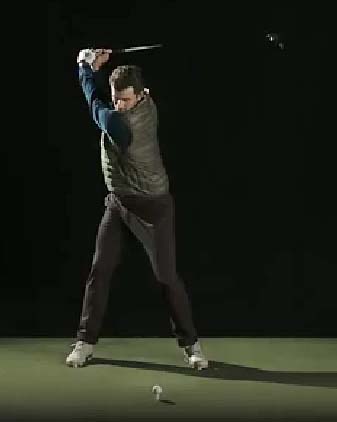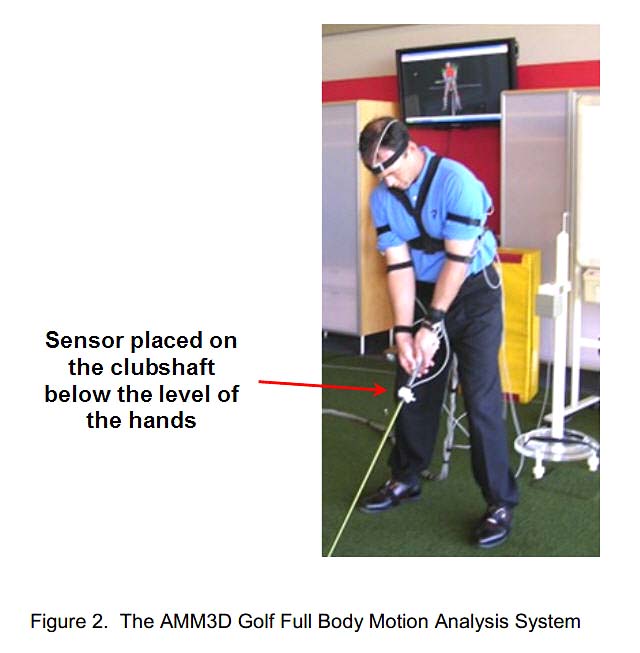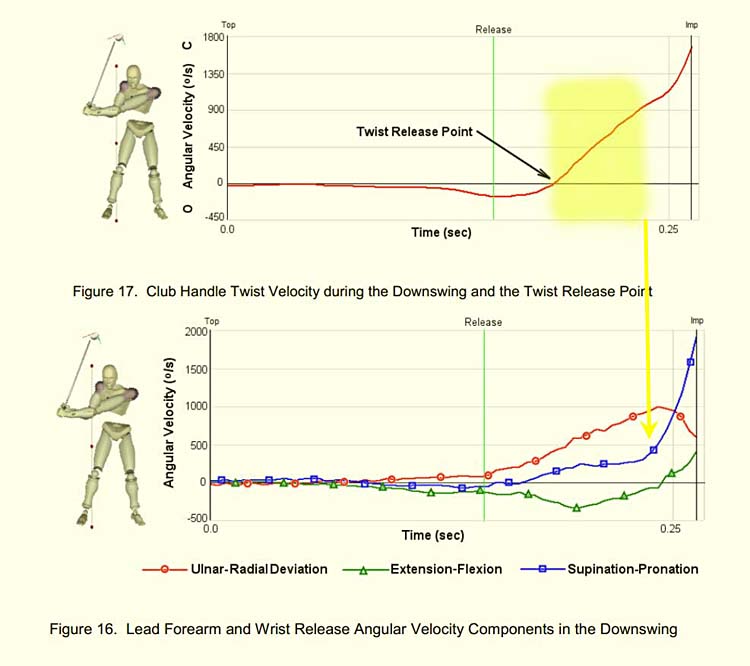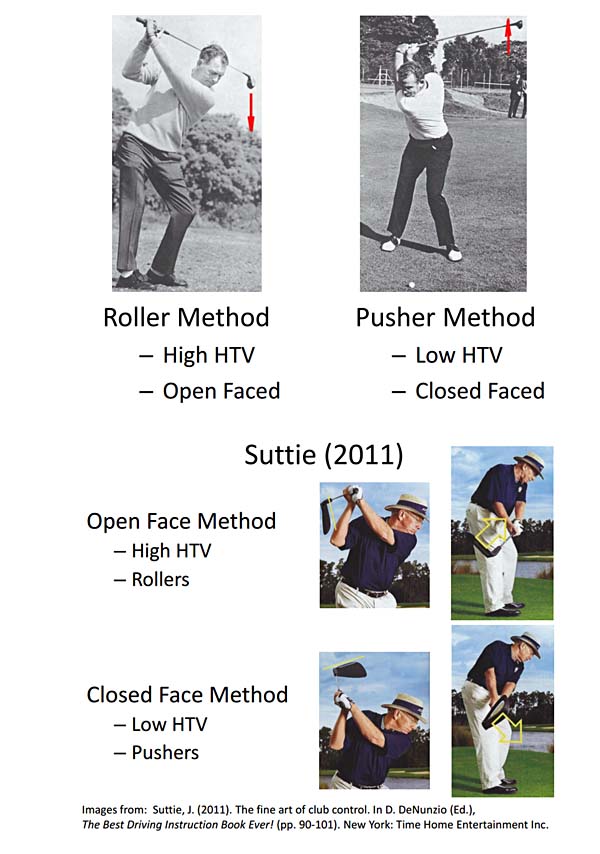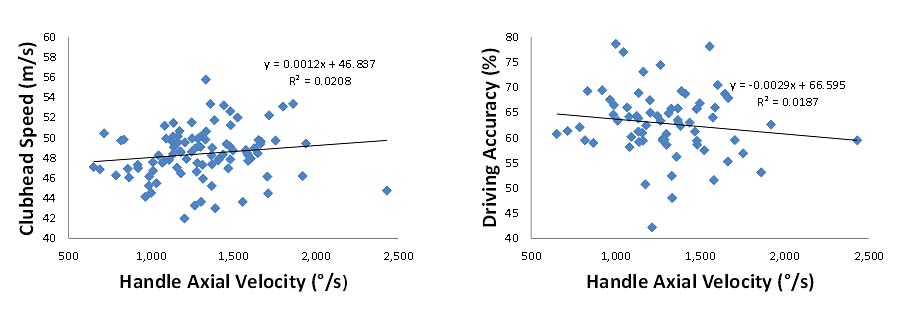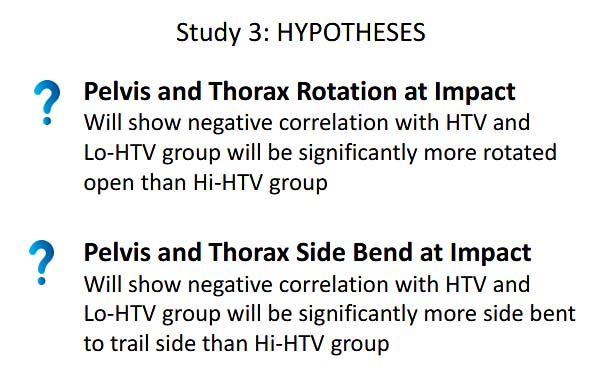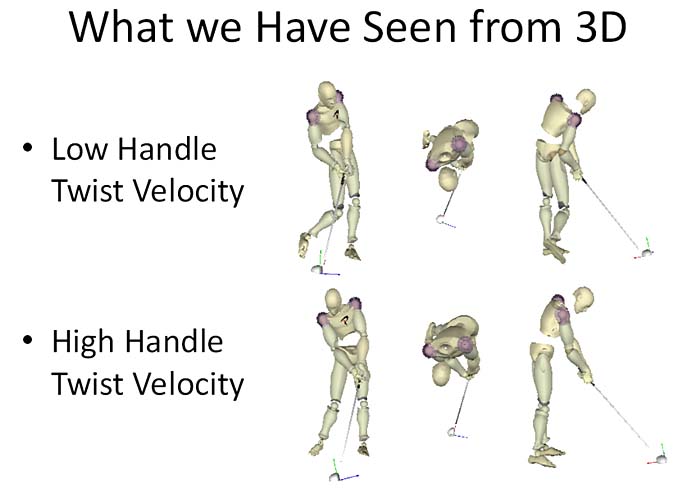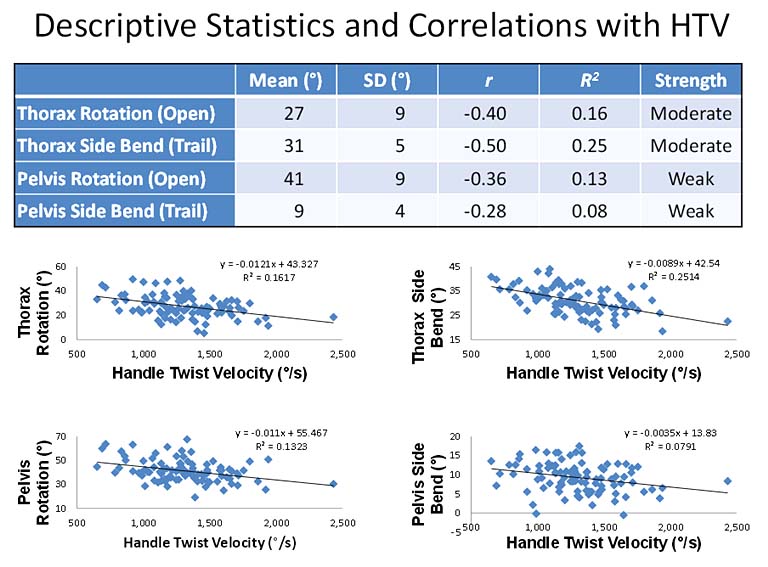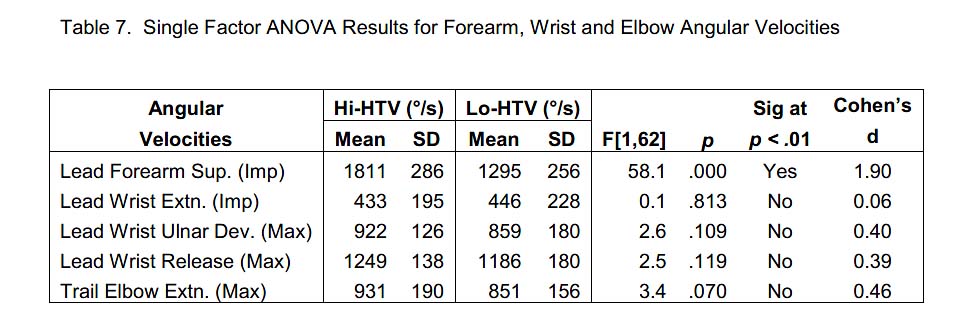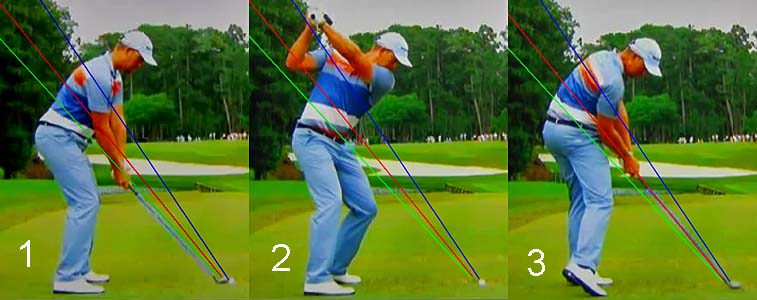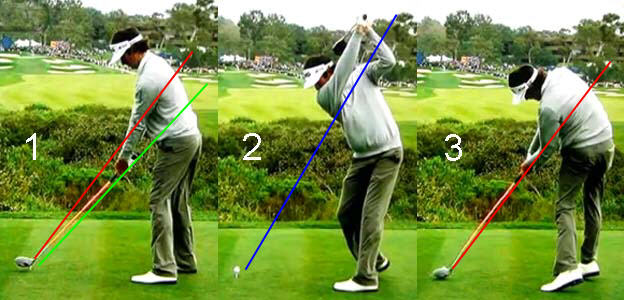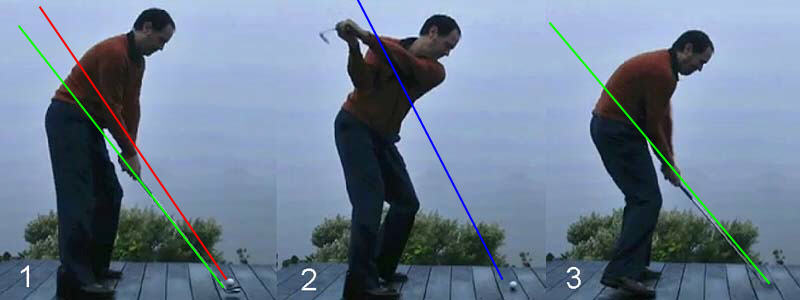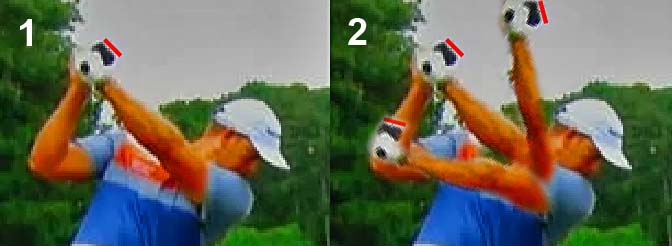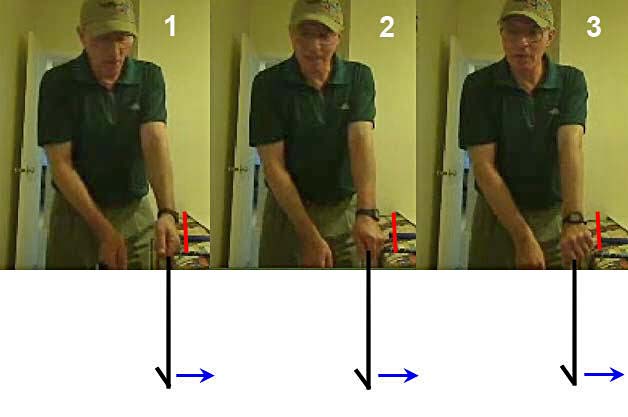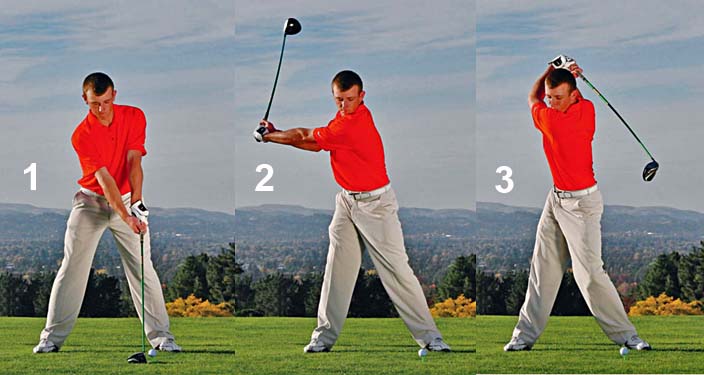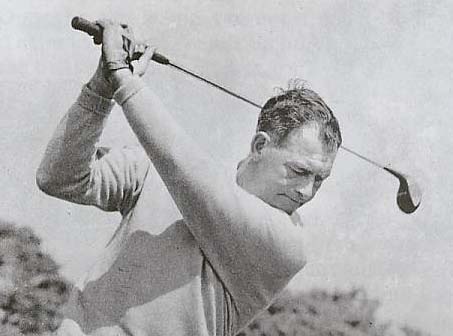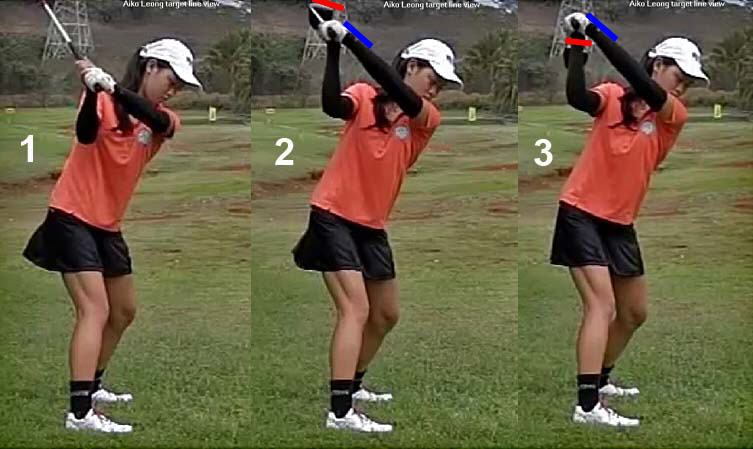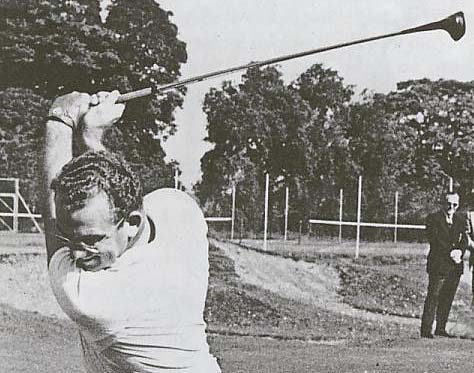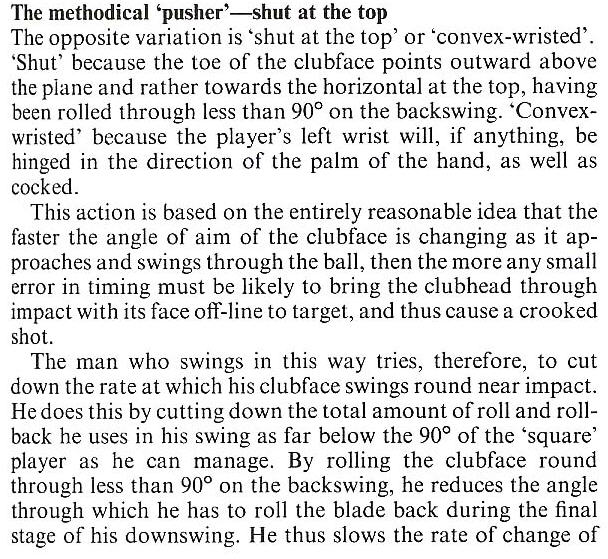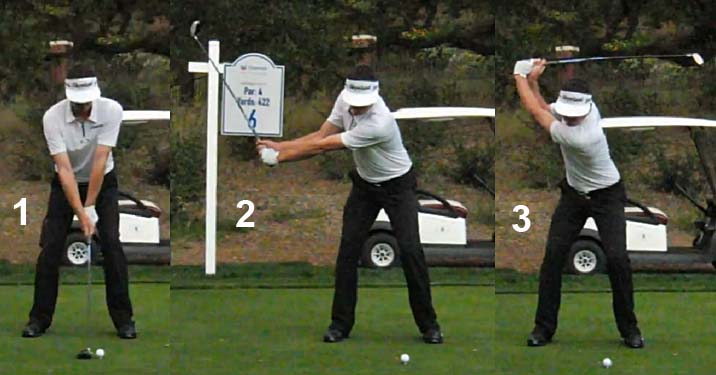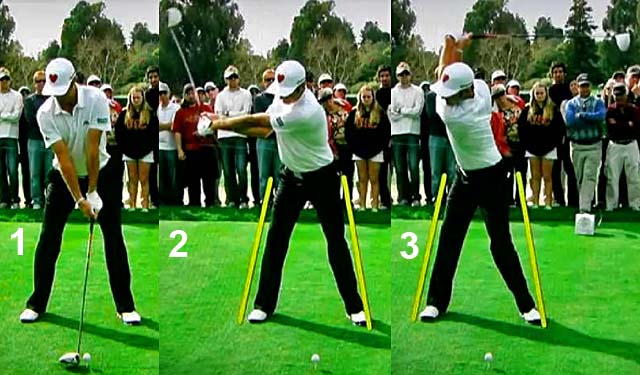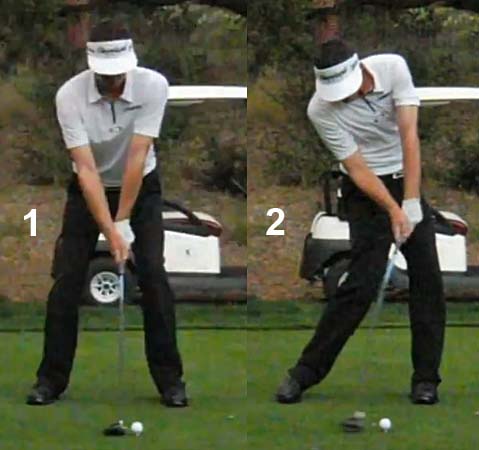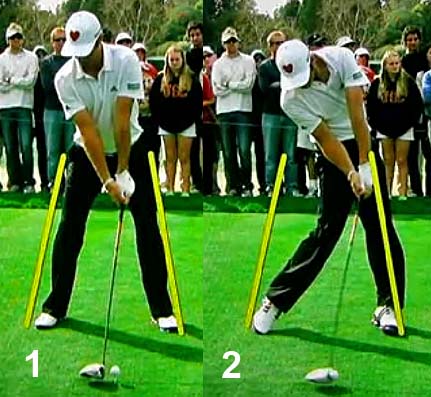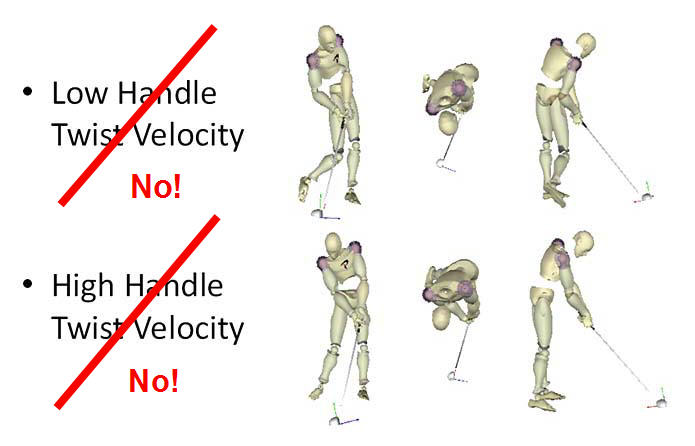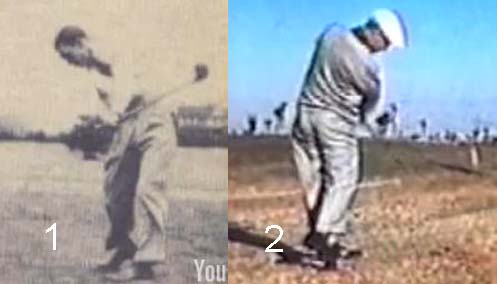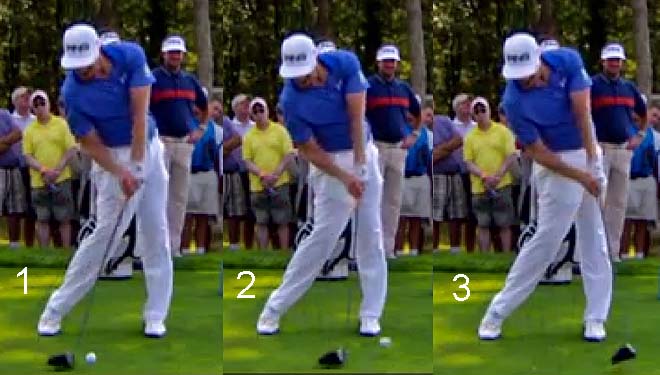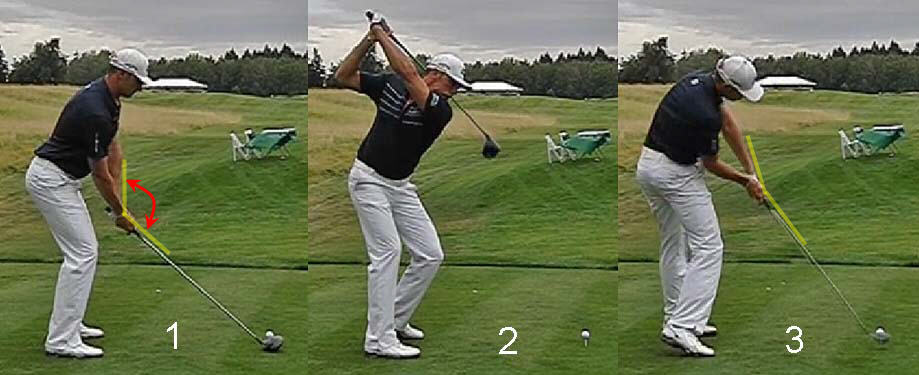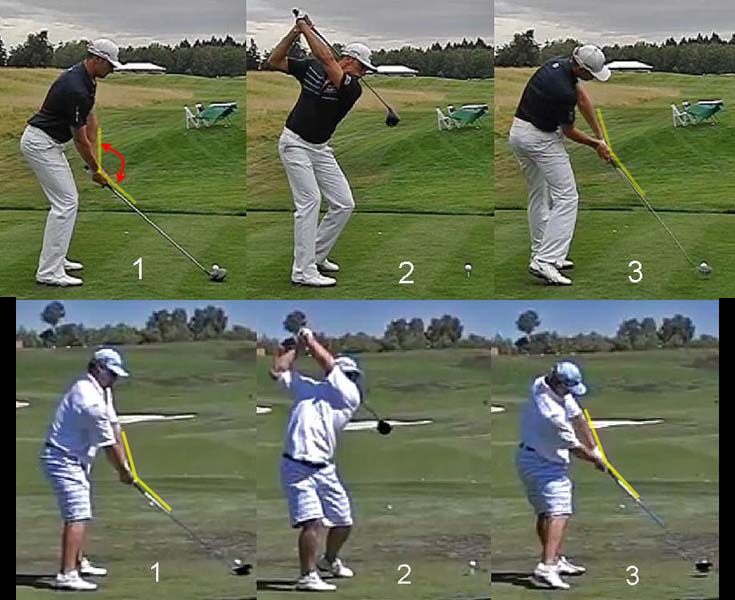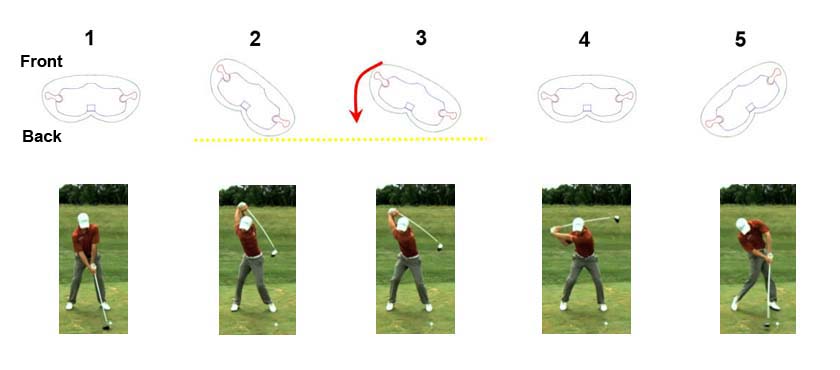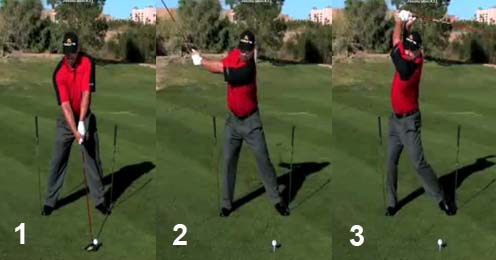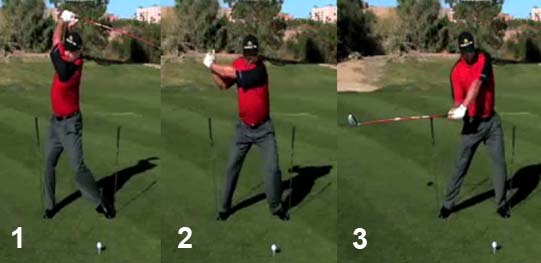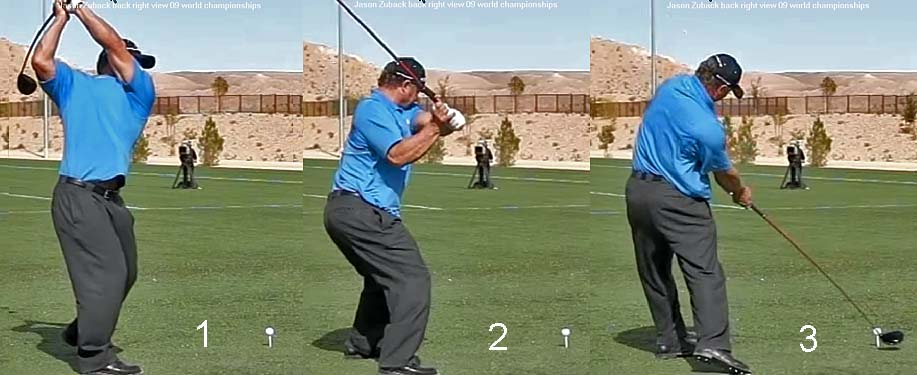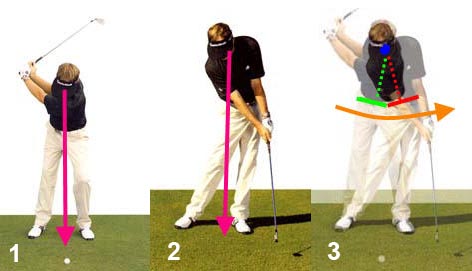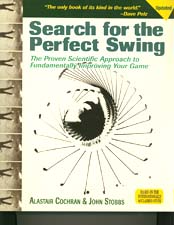Critically Analysing Phil Cheetham's PhD Dissertation-Research Study on the Relationship of Handle Twist Velocity to Selected Biomechanical Characteristics of the Golf Drive
Click here to go back to the home page.
Introduction:
Phil Cheetham, who works as a biomechanist at the Titleist Performance Institute, published his PhD dissertation thesis on his personal website in late 2014 [1], and his dissertation thesis paper details the results of his research study regarding the topic of the handle twist velocity of 94 professional golfers. Phil Cheetham used a 3-D measuring system to measure selected biomechanical characteristics of 94 professional golfers, including their handle twist velocity measurements during the downswing, and he divided the study group into two distinct subgroups with respect to handle twist velocity - i) 32 golfers who had a low handle twist velocity (lo-HTV group) and ii) 32 golfers who had a high handle twist velocity (hi-HTV group). He then studied whether these two subgroups of professional golfers had different driving distances and driving accuracy results. He also postulated that the two different subgroups had different swing patterns in terms of their downswing's biomechanical characteristics, and he finally implied that the results of his research study would be useful for golf instructors, who could better understand that there are two distinct subgroups of golfers who use a different downswing technique to generate either a low, or a high, HTV in their late downswing. I believe that Phil Cheetham's interpretative conclusions are invalid and I will provide a detailed critique of his research study in this review paper. I will first present the details/results of his research study and I will then secondarily explain (in a subsequent "critical analysis" subsection of this review paper) why I believe that his interpretative conclusions are totally invalid.
Details, and results, of Phil Cheetham's research study.
What does the term "handle twist velocity" (or the term "handle axial velocity") mean, and why is it important?
The "handle twist" phenomenon represents the rotation of the clubshaft handle/shaft around its longitudinal axis. Why does the clubshaft's handle rotate about its longitudinal axis? It happens automatically/naturally during the backswing - because the golfer's left forearm naturally rotates clockwise during the backswing action between P1 and P4. Between P1 and P4, a golfer elevates his left arm and also adducts it across his upper torso, and it is biomechanically impossible to get to a standard end-backswing (P4) position without also naturally rotating the left arm/forearm clockwise by a finite amount during that same time period (*presuming a weak/neutral left hand grip).
(* I will use the example of a weak/neutral left hand grip to make it much easier to understand what is happening in the "average" professional golfer's swing action, and I will subsequently discuss the "effect" of adopting a stronger left hand grip in a "critical analysis" subsection of this review paper)
Consider the situation of a golfer who adopts a weak/neutral left hand grip, and who therefore has the back of his GFLW and clubface (which is straight-in-line with his left forearm) facing the target at address - which will only happen if i) the left arm/clubshaft is held in a *straight-line (intact LAFW alignment) relationship with ii) the left arm being held vertically below the left shoulder socket at address.
(* most professional golfers [who use an intact LAFW technique during their backswing/downswing action] prefer to hold the hands roughly centralised between the thighs at address with the clubshaft roughly perpendicular to the ball-target line at address, or they prefer to hold their hands slightly closer to their lead thigh with the clubshaft angled backwards away from the target to a small degree, which means that they may temporarily have to bend their left wrist to a variable degree and disrupt their intact LAFW alignment at address. However, they usually re-establish their intact LAFW alignment as soon as they start their takeaway action, and their temporarily having a non-intact LAFW alignment at address is of no biomechanical/mechanical consequence in terms of their swing action)
Here is a photo showing how the back of the author's GFLW/clubface face the target at address when he adopts a neutral left hand grip with the clubface neutral (and not open or closed) relative to the left forearm.
Author demonstrating a GFLW and intact LAFW using a neutral grip
Note that the clubshaft and left arm are in a straight-line-alignment with the left arm/clubshaft held vertically below the left shoulder socket, and that the left arm/clubshaft is perpendicular to the ball-target line under those conditions. Under those described conditions, note also that both the back of the GFLW (GFLW = geometrically-flat left wrist = f-FLW = functionally-flat left wrist) and clubface will face the target. To get to a square clubface at impact - presuming that the ball is placed at (or very near) low point - a golfer must ensure that the left arm/clubshaft is also in a straight-line-alignment at impact, with the left arm-clubshaft being perpendicular to the ball-target line at impact.Here is an example - featuring Adam Scott.
Adam Scott swing video - https://www.youtube.com/watch?v=nxOOuhMW0kA
Here is a capture image of Adam Scott at low point (image 2).
Adam Scott at low point (image 2) - capture image from his swing video
Note that Adam Scott has a neutral left hand grip and note that the back of his GFLW, and clubface (which is neutrally straight-in-line with his left forearm when he has an intact LAFW), both face the target at low point (red X) which is a mere 2" inches ahead of his tee (and therefore impact). Note that his i) left arm is straight-line-aligned with his clubshaft, that ii) they are both vertically aligned beneath the left shoulder socket, and that iii) they are also simultaneously aligned *perpendicular to the ball-target line, at low point.(* at the impact location, which is few inches behind low point, the clubshaft will not be perpendicular to the ball-target line and it will have a small degree of forward shaft lean, but the amount is very small and not consequential when it comes to the topic of "how much the handle twists about its longitudinal axis secondary to the natural phenomenon of left forearm supination that naturally happens during the downswing's P6 => P7 time period)
At the end-backswing position, a golfer (who adopts a weak/neutral left hand grip) should have the back of his left lower forearm (watchface area) and the back of his GFLW (if he maintains an intact LAFW) roughly parallel to the surface of the inclined plane, which means that he had to rotate his left arm/forearm clockwise by a finite amount during the P1 => P4 time period in order to achieve that goal. Then, during the downswing, he has to reverse the process and rotate his left arm/forearm counterclockwise by the same finite amount so that he can again get a square clubface at impact (presuming that the ball is placed at low point).
So, consider Adam Scott at his end-backswing position.
Adam Scott at his end-backswing position - capture image from his swing video
Note that his clubshaft is inline with his left forearm, which means that he has an intact LAFW/GFLW at the P4 position. Note that the back of his GFLW is roughly parallel to the inclined plane. Note that his clubface is straight-line-aligned with his left forearm, and that it is also roughly parallel to the inclined plane. If Adam Scott simply elevated his left arm and adducted his left arm by the same amount during the P1 => P4 time period (while rotating his pelvis and upper torso by the same amount), without rotating his left forearm clockwise, then the back of his GFLW would be facing away from the target at P4 and his clubshaft would be vertical (or near vertical) at the P4 position. To get the back of his GFLW roughly parallel to the inclined plane at the P4 position, and his clushaft/clubface also roughly parallel to the inclined plane, he had to rotate his left forearm clockwise during the P1 => P4 time period by a "finite amount". During his downswing action, he has to reverse this rotary process by *exactly the same "finite amount" in order to get the clubface square by low point.(* the amount of left forearm supination happening in the downswing will be fractionally/insignificantly less if the ball is placed behind low point and if the clubshaft has a very small amount of forward shaft lean at impact)
If Adam Scott maintains an intact LAFW/GFLW alignment during his downswing action between P4 and low point, then the counterclockwise rotation of his left forearm will cause the clubshaft to rotate about its longitudinal axis while the clubshaft is moving downwards-and-forwards along the clubshaft's travel arc (as seen in that strobe video - note how the clubface is rotating counterclockwise in image 1 and note that most of the counterclockwise rotation of the clubface happens in the later downswing).
In his research study, Phil Cheetham placed a marker on the clubshaft just below the grip level, and his 3-D measuring system could measure the amount of counterclockwise rotation, and the speed of counterclockwise rotation, of that marker (and therefore the clubshaft) during the downswing time period.
Sensors placed on the body and clubshaft in Phil Cheetham's AMM3D-based system - modified from a capture image obtained from reference number [1a]
Note the white sensor placed on the clubshaft, and note that the sensor is inline with the hosel of the club.Phile Cheetham's 3-D system measured the speed of rotation of that sensor (and therefore the clubshaft's speed of rotation about its longitudinal axis = HTV) in his research study.
Here is a diagrammatic graph from Phil Cheetham's dissertation paper [1a] showing the handle twist velocity during the downswing.
Clubshaft twist velocity graph (figure 17) and lead forearm supination velocity graph (figure 16) - composite capture image adapted/modified from reference number [1a ]
The vertical green line represents the club-release point (and that time point represents the start of the release of PA#2, which is equivalent biomechanically to the start of the passive left wrist ulnar deviation release phenomenon [red graph seen in figure 16]). Note that the twist release point in figure 17 (representing the start of the handle twist phenomenon) happens slighly later in the downswing than the club-release point.Note the stick figure-golfer in that capture image is at the ~P5.5 position, and note that the back of his GFLW and clubface, is roughly parallel to the inclined plane. In other words, the stick figure-golfer has not yet started to rotate the back of his GFLW/clubface counterclockwise during the early-mid downswing time period (note that the red "handle twist velocity" graph prior to the twist release point is close to zero in figure 17). Note that the handle twist velocity starts to increase after the twist release point (see red graph in figure 17), which happens when the left forearm starts to supinate (see blue graph in figure 16). Note that the speed of left forearm counterclockwise rotation increases dramatically in the later downswing (see blue graph in figure 16 - immediately after the vertical yellow arrowed line) and note that the handle twist velocity (red graph in figure 17) also increases significantly during that same time period (representing the time period of the PA#3 release action). Note that the handle twist velocity graph, and also the left forearm supination velocity graph, reach their maximum velocity at impact.
When Phil Cheetham refers to handle twist velocity (HTV) measurements in his dissertation paper, he is specifically referring to HTV measurements obtained (at a sampling rate of 240Hz) just prior to impact (during the late PA#3 release time period). According to Phil Cheetham, "impact on the AMM system is considered as the immediate sample before the club passes the club face position at address. So if the clubhead is traveling at say 108mph (the average for my pro database) then in 4.17 ms it will have traveled 7.98 inches. So the handle twist velocity is measured anywhere from 0 to about 8 inches before impact. Probably on average at about 4 inches before impact, or 1/2 a sample period". Phil Cheetham noted that professional golfers varied in their HTV measurements (obtained just prior to impact). He selected 64 golfers from his study sample of 94 golfers - selecting 32 golfers who had the lowest HTV measurements (and who represent the lo-HTV subgroup) and selecting 32 golfers who had the highest HTV measurements (and who represent the hi-HTV subgroup).
Here are their HTV values (in degrees/second).
Hi-HTV Group = 2432 to 1408 (Average 1631 SD 205)
Lo-HTV Group = 1173 to 652 (Average 1173 SD 150).
What causes these 64 professional golfers to have such a large difference in their HTV measurements (high versus low) just before impact?
I believe that there are two theoretical possibilities for this variance in their HTV readings.
1) The first possibility is that you could have two different professional golfers, who both use a neutral left hand grip, and who both have the same amount of left forearm pronation happening during their backswing's P1 => P4 time period (and who therefore both have the same amount of left forearm supination happening during their downswing's P6 => P7 time period) - but who vary in their pattern of left forearm supination happening during the P6 => P7 time period, and who may therefore have different HTV readings measured just prior to impact. I have previously demonstrated that there are two different left forearm supination patterns that can be used during the downswing in my impact chapter - i) the intact LAFW and standard PA#3 release action pattern (manifested by Henrik Stenson) and the ii) "early left forearm supination + left wrist palmar flexion" pattern (manifested by Gary Woodland) - and interested readers can read the relevant section of my impact chapter if they want to better understand this issue.
2) The second possibility is that different professional golfers could vary in the total amount of left forearm pronation happening during the backswing's P1 => P4 time period, and therefore vary to the same degree in the total amount of left forearm supination happening during the downswing's P6 => P7 time period. In other words, professional golfers could vary regarding the total amount of left forearm supination that happens during their PA#3 release action, and professional golfers who manifest a small amount of left forearm supination during their PA#3 release action will likely generate lo-HTV measurements, while professional golfers who manifest a large amount of left forearm supination during their PA#3 release action will likely generate hi-HTV measurements.
Interestingly, Phil Cheetham did not produce any data in his PhD dissertation paper to show that lo-HTV golfers vary in the total amount of left forearm supination that happens during their PA#3 release action (compared to hi-HTV golfers) and he only produced data/graphs that measure the velocity of left forearm supination and/or the velocity of the handle's rotation about its longitudinal axis. Also, Phil Cheetham did not even explore/discuss the first possibility as being a possible primary causal factor regarding the variance in the HTV measurements between the lo-HTV golfers and the hi-HTV golfers, and he seemingly only considered the second possibility as being the primary causative factor responsible for the HTV measurement differences between the lo-HTV golfers and the hi-HTV golfers.
Why do professional golfers vary in the total amount of left forearm pronation that happens during their backswing action?
Here is Phil Cheetham's explanation in the form of a direct (unedited) quote from his PhD dissertation paper [1a]-: "Cochran and Stobbs (1968) dedicate a chapter of their book, “Search for the Perfect Swing” to different types of club axial twist action in the backswing and downswing. They call the golfers that use the different handle twisting actions; Squares, Rollers, and Pushers. The Rollers twist the handle of the club more, so that at the top of backswing the club face is open to the swing plane. Pushers only twist the club handle a small amount and so the clubface is closed to the swing plane at the top of backswing. They state that the Rollers will use their arms more in the downswing than the Pushers, whereas the Pushers will use their body more in the downswing than the Rollers. Suttie (2011) also discusses differences between methods of clubface control during the swing. He groups the methods into three categories, Square-Face, Open-Face or Closed-Face, which he adapted from Cochran and Stobbs. His Open-Face technique corresponds to the Rollers, and the Closed-Face technique corresponds to the Pushers. Open-Face technique golfers have the club face open at the top of backswing and so have to close it rapidly in the downswing because they have a large twist angle to rotate the handle through to get the face square at impact. This corresponds to the high HTV technique in our study. The Closed-Face method golfers have the clubface closed at the top of backswing and so do not have to close the face rapidly in the downswing because they have a small twist angle to rotate the handle through to get the face square at impact. This corresponds to the low HTV technique in our study. The Square-Face method has a club face angle at top which is intermediate between the Open-Face or Closed-Face methods."
Here is a capture image from Phil Cheetham's PhD dissertation paper that graphically represents this described difference between "Rollers" (open-face golfers), who "supposedly" represent the hi-HTV golfers, and "Pushers" (closed-face golfers) who "supposedly" represent the lo-HTV golfers, in his research study.
Rollers versus Pushers - composite image created from two separate images from reference [1a]
Note that I bold-highlighted certain statements in Phil Cheetham's unedited quote - where he equates the speed of handle twisting in the downswing (hi-HTV golfers versus lo-HTV golfers) with the amount of twist angle manifested at the P4 position (based on how open the clubface is relative to the swingplane at the end-backswing position). I think that Phil Cheetham is making a major mistake by implying that the hi-HTV golfers in his research study are "Rollers" (as demonstrated in that image) and that the lo-HTV golfers in his research study are "Pushers" (as demonstrated in that image). This "belief" of Phil Cheetham's is not supported in his PhD dissertation paper with any factual evidence where he shows that lo-HTV golfers have their clubface closed to the swingplane at their P4 position due to a lesser amount of left forearm pronation happening during their backswing action secondary to the adoption of a "Pusher" swing technique, and that hi-HTV golfers have their clubface open to the swingplane at their P4 position due to a larger amount of left forearm pronation happening during their backswing action secondary to the adoption of a "Roller" swing technique. He is simply implying that this variance in swing technique between "Pushers" and "Rollers" is the primary causative factor responsible for the large difference in HTV measurements between the lo-HTV golfers and hi-HTV golfers in his research study. I have many *objections to his evidence-unsupported "belief", and I will discuss my objections in great detail in a "critical analysis" subsection of this review paper.(* It is too complicated to discuss my "objections" in great detail at this point, but do note that the b&w "Roller" and "Pusher" images {which are derived from the Cochran & Stobbs book [2]} in the above composite image have their watchface on their left lower forearm angled (relative to the ground or to the swingplane) by nearly the same amount at their end-backswing position, thereby implying that they used nearly the same amount of left forearm pronation during their backswing action, and that their clubface is open/closed relative to the swingplane because of the large differences in their left wrist alignment - being overtly cupped in the "Roller" and overtly arched/bowed in the "Pusher". Bending or arching of the left wrist at the P4 position disrupts the intact LAFW alignment and causes the clubshaft/clubface to no longer be straight-in-line with the left forearm, and that's why the clubface is closed to the swingplane in the "Pusher" and open to the swingplane in the "Roller". The same explanation accounts for the open clubface, and closed clubface, in the two Suttie images - note that the clubface is not straight-in-line with his left forearm in those two images due to the superadded left wrist misalignments)
However, there is a rational, and simple, explanation that can easily explain why professional golfers vary in the amount of left forearm pronation that naturally/automatically happens during their backswing's P1 => P4 time period, and that doesn't involve any disruption of an intact LAFW alignment due to left wrist flexion/extension hinging motions, and that explanation relates to variations in a professional golfer's adopted left hand grip strength. Golfers who adopt a weak/neutral (1-2 knuckle) left hand grip at address will have far less left forearm pronation at address [compared to golfers who adopt a very strong (4+ knuckle) left hand grip at address], and they will therefore have to rotate their left forearm more clockwise during their backswing's P1 => P4 time period in order to get the back of their left lower forearm (watchface area) parallel to the inclined plane at their end-backswing position. In other words, there is a simple, but biomechanically-valid, explanation for variances in the amount of left forearm pronation happening during the backswing of different professional golfers and it doesn't involve any alteration in swing technique, or any disruption of an intact LAFW alignment during either the backswing or downswing. Therefore, one doesn't have to postulate that some professional golfers "artificially" restrict/exaggerate the amount of left forearm pronation happening during their backswing action, and I personally don't believe that there is any scientific evidence that demonstrates that any *"artificial" restricted/exaggerated left forearm pronation phenomenon happens frequently in professional golfers.
Surprisingly, Phil Cheetham did not even study the effect of variances in left hand grip strength on the amount of left forearm pronation that very likely happens automatically/naturally during the backswing actions of those 64 hi-HTV/lo-HTV golfers, and he missed an easy opportunity to possibly demonstrate that left hand grip strength variations cause professional golfers to vary considerably in the amount of left forearm pronation that automatically/naturally happens during their backswing action, and that these left hand grip strength variations may automatically/naturally be responsible for those "expected" variations in HTV measurements (high versus low) obtained just prior to impact.
Now, let's consider what effect variations in the amount of left forearm pronation happening during the backswing action - which we will presume is causally responsible for the variations in HTV measurements obtained in those 64 golfers (32 lo-HTV golfers and 32 hi-HTV golfers) - have on driving distance and driving accuracy.
Phil Cheetham's study hypothesis was that golfers who use a hi-HTV swing technique would drive the ball further, but less accurately, than lo-HTV golfers. What intellectual justification did Phil Cheetham supply for his study's hypothesis? Phil Cheetham referred to the Cochran & Stobbs book [2] as the source for his hypothesis and this is a direct (unedited) quote from his PhD dissertation paper-: "Cochran and Stobbs break golfers into three categories; Rollers, Squares, and Pushers, based on how much they twist the club shaft on the backswing and consequently on the downswing. Rollers twist the club more than 90°, Squares 90°, and Pushers less than 90°. They suggest that Pushers will tend to be more accurate because having less than 90° to twist the club back to impact means they can have a slower rate of change of the face angle in the downswing making it easier to get consistently square at impact. They suggest that while this lower twist angle method may have the potential for more accuracy it will lose the mechanical advantage of the “screwdriver action” (p. 96) and will be a less powerful swing. On the other hand Rollers will have more difficulty with the timing, thus affecting their accuracy, but the increased scope of the “screwdriver action” will make their swing more powerful."
Here are the actual clubhead speed (which is an acceptable surrogate marker for driving distance) and driving accuracy results published in Phil Cheetham's PhD dissertation paper.
Clubhead speed and driving accuracy of 64 professional golfers - composite image created from two capture images from reference number [1a]
One can clearly see that there is no correlation between HTV and i) driver clubhead speed at impact (which is an acceptable surrogate marker for driving distance) or ii) driving accuracy.Are you surprised?
I am not personally surprised to discover that hi-HTV golfers did not generate higher clubhead speeds than lo-HTV golfers. Why should they? Cochran & Stobbs talk about a "screwdriver action", which is a crude way of referring to the PA#3 release action (which is biomechanically due to left forearm supination) that mainly happens in the late downswing between P6.5 and P7. TGM-literalists refer to the release of PA#3 as a swing power source, and it should therefore theoretically make sense that hi-HTV golfers (who use a greater amount of PA#3 release action in their downswing action) would generate more swing power than lo-HTV golfers, but I no longer subscribe to that "TGM-belief", which I now think is wrongheaded. I no am longer inclined to think of the PA#3 release action as being a "power accumulator" type of swing power source in a TGM swinging action (even though its was labelled a power accumulator by Homer Kelley), and I believe that the only purpose of the biomechanical action (underlying a PA#3 release action) is to square the clubface by impact. I now believe that the only major swing power sources in a TGM swinging action (which is the swing technique used by most professional golfers) are due to the sequential release of PA#4 => PA#2, and I think that there is no reason to expect that hi-HTV golfers will be able to generate more swing power using those two power accumulators than lo-HTV golfers. Why should hi-HTV golfers be able to generate more swing power if i) their active pivot action that powers the release of PA#4, and ii) their PA#4 loading/unloading action, and iii) their PA#2 loading/unloading action are equally as efficacious as those manifested by lo-HTV golfers? Phil Cheetham didn't present any evidence in his research study to suggest that his study's two subgroups had different levels of efficacy in terms of those three swing power generating actions.
What about driving accuracy? Theoretically, one would expect that hi-HTV golfers would be less accurate than lo-HTV golfers because it is theoretically more difficult to "time" the release of PA#3 and square the clubface by impact if one is generating a higher HTV motion in the later downswing. The fact that this "expectation" didn't happen in this particular study of 64 golfers could be due to a number of factors. The one possibility is that the 32 hi-HTV golfers in this study had an inordinately/disproportionately good ability to "time" their PA#3 release action relative to the "average" professional golfer, who also uses a hi-HTV downswing action. Alternatively, there could be another major confounding variable in play, which biased the results, because that confounding variable was not equally distributed between the hi-HTV golfers and lo-HTV golfers. A major confounding variable (relating to the issue of driving the ball accurately straight) is a golfer's ability to use a drive-hold (DH) hand release action, rather than a non-DH hand release action, through the immediate impact zone between P6.9-P7.2. I believe that a golfer needs to square the clubface by impact in order to drive the ball accurately straight, but I simultaneously believe that his ability to consistently drive the ball accurately straight is also dependent on his ability to maintain that square clubface stable for a few inches through impact. I believe that DHers (by definition) are more likely to maintain a stable square clubface through impact than non-DHers, and I do not know whether there was an equal number of DHers in the lo-HTV subgroup as there were in the hi-HTV subgroup. Phil Cheetham's 3-D system can only obtain HTV measurements at a sampling rate of 240Hz, which is far too low to determine whether a golfer is maintaining a stable clubface (which doesn't significantly flip-or-roll) through impact. I believe that a much higher HTV sampling rate of ~5,000-10,000 Hz would be required to determine whether a professional golfer is a DHer, versus a non-DHer, and Phil Cheetham didn't explore the issue as to whether there was an equal distribution of DHers in his study's two subgroups. Confidence in the legitimacy of the results of a golf research study is determined by the research study's sample size and its signal/noise ratio - in a similar way that confidence in a randomised clinical trial's results is dependent on its sample size and signal/noise ratio [3] - and I think that Phil Cheetham's research study may be hampered by the fact that it has a very small sample size and a potentially low signal/noise ratio (due to the potential presence of major confounding variables that may not be distributed equally between the research study's two subgroups).
Phil Cheetham not only tested whether hi-HTV golfers could drive the ball as far, and as accuratedly, as lo-HTV golfers - he also studied selected biomechanical characteristics of their swing action to determine whether hi-HTV golfers used a different swing technique than lo-HTV golfers. Phil Cheetham seemingly believes that hi-HTV golfers use a different swing technique than lo-HTV golfers, and he seemingly used Cochrane & Stobbs and Jim Suttie as the source for his "belief", which he formulated as one of his study's secondary hypotheses.
Phil Cheetham formulated the following two hypotheses as scientific hypotheses to be tested in his research study-:
Study 3 hypotheses - capture image from reference [1b]
Note that Phil Cheetham hypothesised that lo-HTV golfers would have a more open pelvis/upper torso (thorax) and more right lateral bend than hi-HTV golfers.This is how Phil Cheetham seemingly envisioned the likely appearance of a lo-HTV golfer and a hi-HTV golfer at impact.
Golfer's posture at impact - capture image from reference number [1a]
Note that he has drawn stick figures of the lo-HTV golfer as having a very open pelvis, and a slightly less open upper torso (thorax) at impact and he has also depicted the lo-HTV golfer as having a lot of right lateral bend. By contrast, he has drawn stick figures of the hi-HTV golfer as having a nearly square pelvis in the DTL view and only a borderline open pelvis in the face-on view, and he has drawn the upper torso (thorax) as being even less open than the pelvis at impact.Why did Phil Cheetham hypothesise that lo-HTV golfers would have a much more open pelvis/upper torso (thorax) at impact than hi-HTV golfers?
Here is the theoretical underpinning for Phil Cheetham's "belief" (hypothesis) as expressed in his PhD dissertation paper-: "Cochran and Stobbs (1968) dedicate a chapter of their book, “Search for the Perfect Swing” to different types of club axial twist action in the backswing and downswing. They call the golfers that use the different handle twisting actions; Squares, Rollers, and Pushers. The Rollers twist the handle of the club more, so that at the top of backswing the club face is open to the swing plane. Pushers only twist the club handle a small amount and so the clubface is closed to the swing plane at the top of backswing. They state that the Rollers will use their arms more in the downswing than the Pushers, whereas the Pushers will use their body more in the downswing than the Rollers. Suttie (2011) also discusses differences between methods of clubface control during the swing. He groups the methods into three categories, Square-Face, Open-Face or Closed-Face, which he adapted from Cochran and Stobbs. His Open-Face technique corresponds to the Rollers, and the Closed-Face technique corresponds to the Pushers. Open-Face technique golfers have the club face open at the top of backswing and so have to close it rapidly in the downswing because they have a large twist angle to rotate the handle through to get the face square at impact. This corresponds to the high HTV technique in our study. The Closed-Face method golfers have the clubface closed at the top of backswing and so do not have to close the face rapidly in the downswing because they have a small twist angle to rotate the handle through to get the face square at impact. This corresponds to the low HTV technique in our study. The Square-Face method has a club face angle at top which is intermediate between the Open-Face or Closed-Face methods. Suttie also outlines the swing characteristics that these different golfers will need to perform in order to complete the different techniques successfully. He states that the Open-Face golfers must have slow to medium hips, suggesting that their hips won’t be very open to the target at impact. In contrast the Closed-Face golfers must use their bodies more because their hands are not as dominant when compared with the Open-Face golfers. This, he states, means that their body will be more open to the target at impact. Now if the golfer’s body is more open at impact it also may follow that the body will be more side bent towards the ball. This will aid the golfer in reaching the ball and making solid contact. On the other hand the golfer whose body is not as open at impact will not need to side bend as much to make good contact. Adapting the concepts of these authors to our research, it follows that the Lo-HTV group will be more open to the target and more side bent to the trail side at impact than the Hi-HTV group. Consequently it is hypothesized that there will be a negative correlation between HTV and pelvis rotation, thorax rotation, pelvis side bend and thorax side bend."
I have bold-highlighted certain statements made by Cochran & Stobbs and Jim Suttie (and reported second-hand by Phil Cheetham in his paper). I personally believe that there is no rational justification for their "beliefs" and I think that their opinions are totally wrongheaded (irrational). I agree that professional golfers may look like either of those two stick figures images at impact, but the primary causal reasons have nothing to do with the "fact" that they may also choose to use either a lo-HTV or a hi-HTV swing technique. I believe that there are other swing technique choices that primarily determine a golfer's postural alignment at impact eg. i) the choice as to whether a golfer wants to use a no-roll hand release action versus a full-roll hand release action; ii) the choice as to whether the golfer wants to use a CP-arm release action versus a CF-arm release action; iii) the choice as to whether the golfer chooses to have his clubshaft's planar travel located on the TSP through the general impact zone (between P6 and P8) rather than having his clubshaft's planar travel being located on a much shallower plane (eg. much closer to the hand plane); and iv) the choice as to whether the golfer chooses to use a reverse group pattern of COP weight-pressure shifting in his downswing (like Bubba Watson) rather than choosing to be a front-foot golfer (like Grant Waite). I will discuss the issue of factors affecting the "body's postural alignment at impact" in much greater detail in a "critical analysis" subsection of this review paper.
Note also that Phil Cheetham claims in that image that his research study's results supported his hypothesis (when he stated "what we have seen from 3D"). However, I totally disagree with his personal interpretative conclusion that implies that his research study's results conclusively verified his study 3 hypothesis.
Here are the results of his research study's testing of his study 3 hypothesis (as published in his PhD dissertation paper).
Postural alignment elements of hi-HTV and lo-HTV golfers at impact - composite image adapted from a number of separate images in reference number [1a]
I personally think that the correlation coefficient values (r values) of -0.40 for upper torso (thorax) rotation and -0.36 for pelvis rotation are very unimpressive and I do not think that those results suggest a strong correlation [4]. I am also very unimpressed with the coefficient of determination values (R squared values) of 0.16 for upper torso (thorax) rotation and 0.13 for pelvic rotation (which suggest that <20% of the variance in Y is determined by any variance in X). I personally think that the statistical results do not strongly support Phil Cheetham's study 3 hypothesis. Also, always remember the statistician's adage that "correlation does not equal causation". I can think of many other causal factors that can rationally explain why certain professional golfers will more likely look the lo-HTV stick-figure, rather than the hi-HTV stick figure, at impact, and I will discuss those biomechanical factors in greater detail in a "critical analysis" subsection of this review paper.
Critical analysis of Phil Cheetham's research study
In this section of my review paper, I am going to thoroughly detail why I believe that Phil Cheetham's interpretative conclusions regarding his research study are totally invalid.
Phil Cheetham had a data base of 3-D measurements of 94 professional golfers, and he noted that 32 of those golfers had a lo-HTV measurement, while 32 golfers had a hi-HTV measurement, immediately pre-impact. Fair enough! He then examined selected biomechanical characteristics that those 64 golfers manifested during their downswing (eg. left wrist flexion/extension patterns, left forearm supination patterns, and left wrist radial/ulnar deviation patterns). Here are the results of his study of those selected biomechanical characteristics - as published in his PhD dissertation paper.
Selected biomechanical characteristics versus HTV - capture image from reference number [1a]
Phil Cheetham studied the differences in the velocity of lead forearm supination, lead wrist extension, lead wrist ulnar deviation, lead wrist release and trail elbow extension between hi-HTV and lo-HTV golfers and he found that that there was a significant and large difference in lead forearm supination measurements between hi-HTV and lo-HTV golfers, and no significant differences in the other selected biomechanical characteristics. I therefore think that it was very reasonable for him to infer that the differences in the speed of left forearm supination (speed of the release of PA#3) was the primary biomechanical feature differentiating the two subgroups. So, I think that it was also entirely logical for him to surmise that hi-HTV golfers may have more left forearm pronation happening during their backswing action (that would be directly proportional to the amount, and velocity, of left forearm supination happening during their PA#3 release action) than lo-HTV golfers. However, what really surprised me is that Phil Cheetham did not immediately pursue a study of variations in left hand grip strength to determine whether that biomechanical parameter correlated with HTV. I contacted Phil Cheetham (via a personal e-mail communication) and asked him why he did not study the relationship between left hand grip strength and the amount of left forearm pronation happening in the backswing action of the hi-HTV and lo-HTV golfers, but he did not reply with an answer to my question. I think that variations in left hand grip strength is the most likely reason why hi-HTV golfers would have more left forearm pronation happening during their backswing action, and I suspect that the hi-HTV subgroup of golfers probably have a disproportionate number of golfers with a weak/neutral left hand grip, while the lo-HTV subgroup of golfers probably have a disproportionate number of golfers with a very strong left hand grip. Why do I believe that there is a strong inverse relationship between left hand grip strength and the total amount of left forearm pronation happening during the P1 => P4 time period? To best answer that question, I first need to explain what is meant by the term "swingplane" and I also need to explain how variations in swingplane steepness affect the amount of left forearm pronation happening during the backswing of golfers who adopt a relatively neutral (non-strong) left hand grip.I discussed the topic of the swingplane in my "Swingplane" review paper, and I used the following image of Aaron Baddeley to describe the swingplane concept.
Swingplane shifts - capture images from a swing video
Note that I have drawn three plane lines - the hand plane, the elbow plane and the turned shoulder plane (TSP).Image 1 is at address, image 2 is at the end-backswing position and image 3 is at impact.
The hand plane is essentially the clubshaft-at-address plane (image 1). A line is drawn along the length of the clubshaft at address and extended through the hands. This line often hits the golfer's body at the level of the belt buckle and exits the back just above the pelvis.
The elbow plane is a line drawn from the ball through the right elbow (image 1). Note that the elbow plane line usually exits the back at the level of the mid-back.
The turned shoulder plane is a line drawn from the ball to the right shoulder at the end-backswing position (image 2).
Many professional golfers shift their hands/clubshaft from the hand plane to the turned shoulder plane (TSP) during the backswing and this represents a plane shift swing. Aaron Baddeley has a double plane shift swing - during the backswing he shifts his hands/clubshaft from the hand plane to a position just above the right shoulder (just above the TSP), and during the downswing he shifts his hands/clubshaft from the turned shoulder plane (TSP) to the elbow plane. This is the most frequent type of plane shift seen in professional golfers (hand plane => TSP during the backswing; and TSP => elbow plane during the downswing).
Consider a number of other golfers who manifest different double plane plane shift patterns, and who also have their left arm at a different level of steepness at their end-backswing position.
Henrik Stenson
Henrik Stenson's swingplane shifts - capture images from a swing video
Hand plane = Green; elbow plane = red; and TSP = Blue.Image 1 is at address, image 2 is at the end-backswing position and image 3 is at impact.
Note that Henrik Stenson has a double plane shift swing and his hands/clubshaft moves from the hand plane (at address) to slightly above the TSP (at the end-backswing position), and then back down to the elbow plane (at impact).
Note that he has an intact LAFW at his end-backswing position (clubshaft is straight-in-line with his left arm). Note that the back of his left hand and clubface are both angled at about 45 degrees to the horizon.
Bubba Watson
Bubba Watson's swingplane shifts - capture images from a swing video
Hand plane = Green; elbow plane = red; and TSP = Blue.
Image 1 is at address, image 2 is at the end-backswing position and image 3 is at impact.
Note that Bubba Watson has a double plane shift swing and his hands/clubshaft moves from the hand plane (at address) to far above the TSP (at the end-backswing position), and then back down to the elbow plane (at impact).
Note that he has an intact LAFW at his end-backswing position (clubshaft is straight-in-line with his left arm). Note that the back of his left hand and clubface are angled parallel to a steeper swingplane at his end-backswing position, that is significantly steeper than Henrik Stenson's end-backswing swingplane, and his clubface is therefore angled steeper than 45 degrees relative to the horizon. Many golfers would label his clubface as being more open at the P4 position because his clubface is more vertical than 45 degrees, and Cochran & Stobbs would presumably infer that he used more lead forearm pronation in his backswing action, and they would presumably therefore label him a "Roller". However, the true reality is that he is using less, and not more, lead forearm pronation during his backswing action than Henrik Stenson - because the back of his lead hand and clubshaft is on a steeper swingplane at his end-backswing position.
John Erickson
John Erickson's swingplane shifts - capture images from a swing video
Hand plane = Green; elbow plane = red; and TSP = Blue.Image 1 is at address, image 2 is at the end-backswing position and image 3 is at impact.
Note that John Erickson has a double plane shift swing and his hands/clubshaft moves from the hand plane (at address) to far below the TSP (at the end-backswing position), and then back down to the hand plane (at impact).
Note that he has an intact LAFW at his end-backswing position (clubshaft is straight-in-line with his left arm). Note that the back of his left hand and clubface are angled parallel to a flatter (far less steep) swingplane at his end-backswing position than Henrik Stenson's end-backswing swingplane, and his clubface is angled flatter than 45 degreees relative to the horizon. Many golfers would label his clubface as being more closed at the P4 position because it is more horizontal than 45 degrees, and Cochran & Stobbs would presumably infer that he used less left forearm pronation in his backswing action, and they would presumbaly therefore label him a "Pusher". However, the true reality is that he is using more, and not less, left forearm pronation during his backswing action than Henrik Stenson - because the back of his left hand and clubshaft is on a flatter swing plane at his end-backswing position.
From these three examples, you should be able to appreciate the fact that there is actually an inverse relationship between the amount of left forearm pronation happening during the P1 => P4 backswing time period and how open/closed the clubface "appears" at the end-backswing position - if the golfer (who has neutral left hand grip) maintains an intact LAFW and avoids any left wrist bowing/cupping motions that disrupt an intact LAFW alignment.
So, consider the relationship between the left arm angle and how open/closed the clubface "appears" at the end-backswing position.
Effect of left arm steepness on clubface angle at the end-backswing position
Image 1 shows Henrik Stenson at his end-backswing position. Note that the clubface is about 45 degrees angled relative to the horizon and it would be classified as being neutral (and not open or closed).Image 2 shows a photoshopped-image where I display left arm angles that are flatter/steeper than Henrik Stenson's "real life" swing (middle left arm image) and you can see that the flatter left arm angle results in a closed clubface and the steeper left arm angle results in an open clubface - while maintaining an intact LAFW that causes the clubface to always be straight-in-line with the left forearm (which naturally happens if the left hand grip strength is neutral). Most professional golfers have their left arm positioned across their shoulder turn angle (or just below/above the shoulder turn angle) like Henrik Stenson. Therefore, their clubface will be relatively neutral (angled at about 45 degrees relative to the horizon) at their end-backswing position if they also adopt a neutral left hand grip and if they maintain an intact LAFW alignment. What will happen if they adopt a stronger left hand grip and then get their left arm to the same steepness angle (as Henrik Stenson's left arm) at their end-backswing position?
If a golfer adopts a stronger left hand grip and gets his left arm to the same (across the shoulder turn angle) position as Henrik Stenson's left arm, then the back of his left hand will also be parallel to the same swingplane at that position - just like the back of Henrik Stenson's left hand. That means that their left forearm is likely pronated as much as Henrik Stenson's left forearm at the end-backswing position. However, they will be manifesting less left forearm pronatory clockwise rotation of their left forearm during their backswing action, because their left forearm is already more pronated at address (in direct proportion to the strength of their left hand grip). In other words, they have already pre-turned their left forearm in a pronatory direction at address, so that their clubface is more closed relative to the back of their left hand/watchface area of their left lower forearm at address.
Consider this example of the author demonstrating three different left hand grip strengths.
Author demonstrating different amounts of left hand grip strength
Image 1 shows a weak/neutral left hand grip; image 2 shows a moderately strong left hand grip; and image 3 shows a very strong left hand grip.Note that my watchface faces the target in image 1 and that it is rotated more away from the target as my left hand grip strengthens - due to pre-turning my left forearm in a pronatory direction before I grip the club (with the clubface always facing the target). Note that the clubface is more closed relative to the back of the left lower forearm (watchface) if I adopt a stronger left hand grip, and it is about 30+ degrees closed in image 2 and about 60+ degrees closed in image 3 when maintaining an intact LAFW (where the clubshaft is in a straight-line-alignment with the left arm). That amount of clubface closure (relative to the back of the left forearm) is static (unchanging) if the golfer (who adopts a very strong left hand grip) maintains an intact LAFW throughout his backswing and if he doesn't change the amount of clubface closure (relative to the back of his left lower forearm) by disrupting his intact LAFW alignment (secondary to either bowing/bending his left wrist during his backswing action). That means that his clubface will be closed (relative to the back of his left lower forearm) by the same amount at his end-backswing position, and if his left arm is angled across his shoulder turn angle (like Henrik Stenson's left arm) at his end-backswing position with the back of his left hand parallel to the same swingplane (as Henrik Stenson's) then his clubface will be more closed relative to the horizon at the end-backswing position. To better demonstrate these points, I will use an example of a golfer who adopts a very strong left hand grip.
Consider an example of golfer who uses a very strong left hand grip - Domenic Mazza.
Here is a link to a slideshow produced by Golf Digest - http://www.golfdigest.com/golf-instruction/swing-sequences/2011-02/photos-domenic-mazza#slide=1
Here are three capture images from that slideshow.
Domenic Mazza's backswing action - capture images from the Golf Digest slide show
Image 1 shows that he has adopted such a very strong left hand grip that the back of his left hand (logo on his glove) is nearly parallel to the inclined plane (rather than facing the target as would be seen in a golfer who adopts a weak left hand grip). Note that his clubface is about 60+ degrees closed relative to the back of his left hand and the watchface area on the back of his left lower forearm area at address.
Image 2 shows him at the P3 position. Note that the back of his left hand and watchface area is roughly parallel to the inclined plane, and that he didn't have to roll his left forearm significantly more clockwise because it was already pre-rolled at address. Note that his clubface is still about 60+ degrees closed relative to the back of his left hand/left lower forearm. His clubface is not rolling open significantly more during his backswing action, but he isn't using any biomechanical technique to "artificially" restrict the amount of left forearm pronation (that happens naturally during his backswing action) in order to achieve this "fact".
Image 3 shows him at the P4 position. Note that the back of his left lower forearm (watchface area) is parallel to the inclined plane (which is steeper than the inclined plane in image 2 because he is still elevating his left arm during the P3 => P4 time period), but note that his clubface is closed to the swingplane and it is not due to any bowing of the left wrist (which creates a non-intact LAFW). His clubface is closed at P4 (relative to the horizon) because it was statically closed relative to the back of his left lower forearm at address, and he simply adducted/elevated his left arm from P1 to P4 without adding much additional left forearm pronation and without changing the degree of static closure of his clubface (relative to the back of his left lower forearm) by disrupting his intact LAFW.
If a professional golfer adopts a very strong left hand grip (like Domenic Mazza), then there will only be a small amount of additional left forearm pronation happening between P1 and P4. Therefore, to get back to a square clubface by impact, very little left forearm supination (minimal PA#3 release action) will be required. I suspect that this is the most likely reason why professional golfers automatically/naturally become low-HTV golfers, and it doesn't involve a change in swing technique.
Golfers who adopt a moderately strong left hand grip will manifest a degree of left forearm pronation during their backswing's P1 => P4 time period that is intermediate in degree between the amount found in golfers who adopt a weak/neutral left hand grip and the amount found in golfers who adopt a very strong (4+ knuckle) left hand grip. To see an example, see my discussion of Keegan Bradley's swing action in topic number 3 of my "2014 update: Revisions and Refinements in my Thinking Regarding Golf Swing Mechanics/biomechanics" review paper.
Now, let's consider the Cochran & Stobbs description of the "Roller" and "Pusher" technique as described in their book [2].
Cochran & Stobbs make the following statement in their book [2] regarding the backswing action of the "Roller"-: "Mechanically, the essence of it is as follows. If the player, rolls his blade through more than 90 degrees, say up to 120 degrees, then he has to roll it back again more quickly during the final stage into impact."
How does a golfer roll the clubface more during their backswing action (according to Cochran & Stobbs)?
Cochran & Stobbs posted this image of Christy O'Connor, who represents a "Roller".
"Roller" swing technique - cropped version of the Christy O'Connor image in reference number [2]
Cochran & Stobbs wrote in their book [2] regarding this image-: "An open or cup-wristed position. At the top of Christy O'Connor's backswing both his clubface and the back of his left hand lie in a vertical plane. This means that his clubface has rolled through an angle of 130 degrees in relation to the plane of his swing. From this position, a lot of forearm roll will be required up to and beyond impact. Notice two other points of interest: i) that O'Connor has grippped his club a few inches from the end of his shaft, and ii) that his left hand has opened a little at the top. A number of good players do this, and they probably add a little speed to the hinger action by closing the fingers and pulling the club back into the palm of the hand again at the right time in the downswing".I think that Cochran & Stobbs are wrong about a number of points. Christy O'Connor's clubface is open to the swingplane at the P4 position not due to any increased left forearm pronation happening during the backswing's P1 => P4 time period, but due to two swing faults manifested by Christy O'Connor - i) he disrupts his intact LAFW by bending his left wrist and straightening his right wrist, thereby angling his clubshaft across-the-plane; and ii) he loosens his left hand grip and uncurls his fingers in such a manner that the clubface rotates even more open. Those two swing faults cannot be corrected by using a "lot of forearm roll up to and beyond impact". A golfer who manifests those two swing faults needs to i) regrip his club and eliminate the left wrist bending phenomenon so that he can acquire an intact LAFW/GFLW - preferably before he even starts the downswing action. If he performs this compensatory corrective action, which will create an intact LAFW/GFLW alignment, long before he gets to his late downswing time period, then he will be using the standard amount of PA#3 release action during his late downswing action (with the actual amount being consistent with the strength of his left hand grip). It is a fallacy to believe that an increased amount of left forearm supination is needed during the late downswing's PA#3 release action in order to correct for a left wrist bending/cupping swing fault that exists at the end-backswing position. Also, I think that it is wrongheaded for Phil Cheetham to claim that the hi-HTV golfers in his research study are manifesting those two swing faults - without presenting any incontrovertible evidence. I think that only a handful of professional golfers have a significantly disrupted LAFW at their end-backswing position due to a marked degree of left wrist cupping that causes their clubshaft to cross-the-line.
Note also that Christy O'Connor has pronated his left forearm a little too much and that causes his left lower forearm (watchface) to be slightly over-rotated at the end-backswing position, and it is not quite parallel to the swingplane. What "effect" does slight over-rotation of the left forearm (due to excessive left forearm pronation at the near-end-backswing position) have on the clubshaft/clubface - if a golfer doesn't simultaneously have Christy O'Connor's two swing faults that cause an open clubface at the P4 position?
Consider Aiko Leong's "laid-off" action, which she enacts during her late backswing action.
Aiko Leong swing video - https://www.youtube.com/watch?v=uUMyb7BIUJQ
Here are capture images from her swing video.
Aiko Leong's end-backswing action - capture images from her swing video
Image 1 shows Aiko Leong at the P3.5 position with an intact LAFW/GFLW and with the back of her left hand/watchface being parallel to the swingplane.Image 2 shows Aiko Leong reaching the end of her backswing action with an intact LAFW/GFLW. Note that her clubface (red line) is slightly closed relative to the back of her left lower forearm (blue line) due to the static closure that is secondary to adopting a slightly strong left hand grip.
Image 3 shows how Aiko Leong over-rotates her left forearm slightly (while maintaining an intact LAFW/GFLW) at her end-backswing position, and the small degree of over-pronation of her left forearm causes her clubshaft to become "laid-off" (more horizontal relative to the horizon) and it also secondarily causes her clubface to become even more closed (and not more open) relative to the horizon. That "laid-off" clubshaft-drooping phenomenon is not seen in Christy O'Connor's backswing because he disrupts his intact LAFW by bending (cupping) his left wrist to such a marked degree that his clubshaft crosses-the-line.
Now, consider what Cochran & Stobbs state about the swing technique of a "Pusher".
Here is the image of a "Pusher" published in their book [2].
"Pusher" - cropped version of the David Thomas image in reference number [2]
Here is an image of "captured text" from their book.
Text on the action of a "Pusher" - from reference number [2]
Cochran & Stobbs are wrong about a number of points. First of all, the "Pusher's" clubface is closed (relative to the horizon and the swing plane) at his end-backswing position not due to a lesser amount of left forearm pronation happening during his backswing action (note that his watchface is parallel to the swingplane which means that he used the standard amount of left forearm pronation during his backswing action that is appropriate for his left arm's angle-of-steepness at his end-backswing position), but due to the fact that he disrupts his intact LAFW/GFLW by arching/bowing his left wrist. Secondly, he will not therefore need less left forearm supination during his PA#3 release action in order to square his clubface by impact - but he will actually need more left forearm supination in order to square his clubface by impact if he maintains an unchanged arched/bowed left wrist throughout his entire downswing action that will result in forward shaft lean at impact. My assertion may seem to be counterintuitive to many golfers, but I have provided the requisite proof when I analysed Dustin Johnson's swing action in great depth in topic number 3 of my "2014 update: Revisions and Refinements in my Thinking Regarding Golf Swing Mechanics/biomechanics" review paper. Dustin Johnson acquires a very arched/bowed left wrist during his late backswing action (that causes his clubface to become very closed to the swingplane at his end-backswing position), and he maintains an unchanged arched/bowed left wrist throughout his entire downswing action, thereby necessitating the use of more (and not less) left forearm supination in his late downswing in order to get a square clubface at impact. Interested readers can read topic number 3 in that review paper if they want to better understand my biomechanical reasoning, because I will not discuss the issue in great depth in this review paper.However, I will provide simple visual proof by comparing Dustin Johnson's swing to Keegan Bradley's swing - seeing that they both adopt a moderately strong left hand grip at address, and seeing that they both get their left arm to roughly the same steepness-angle at their end-backswing positions.
First of all, consider their backswing actions.
Keegan Bradley
Keegan Bradley's backswing action - capture images from a swing video
Note that Keegan Bradley has adopted a moderately strong left hand grip at address (image 1).Note that Keegan Bradley keeps the back of his left hand (watchface) roughly parallel to the swingplane in his mid-backswing (image 2) and end-backswing (image 3) and therefore the amount of additional left forearm pronation that is happening between P1 and P4 is directly proportional to the steepness of his left arm angle at his end-backswing position.
Note that Keegan Bradley has an intact LAFW at his end-backswing position (image 3) and therefore his clubface is angled close to 45 degrees relative to the horizon (actually slightly more closed than 45 degrees due to the presence of a moderately strong left hand grip that produces a finite amount of static clubface closure relative to the back of his left lower forearm).
Dustin Johnson
Dustin Johnson's backswing action - capture images from a swing video
Note that Dustin Johnson also adopts a moderately strong left hand grip at address (image 1), and note that his left forearm is therefore already pre-turned in a pronatory direction to the same degree as Keegan Bradley's left forearm.Image 2 shows Dustin Johnson at the P3 position. Note that his watchface is parallel to the inclined plane, and it is angled very similar (relative to the horizon) when compared to Keegan Bradley's watchface at his P3 position, which means that they have both pronated their left forearm by a similar additional amount between the P1 position and the P3 position. However, note that Dustin Johnson's clubface is slightly more closed than Keegan Bradley's clubface - because Dustin Johnson is already starting to arch/bow his left wrist.
Image 3 shows Dustin Johnson at his end-backswing position. Note that his watchface is roughly parallel to the swingplane, and note that his left arm is angled roughly as steep as Keegan Bradley's left arm (even though Dustin Johnson takes his left arm slightly further back due to a greater amount of upper torso rotation), which suggests that both golfers use a similar amount of additional left forearm pronation during their P1 => P4 backswing actions. However, note that Dustin Johnson's clubface is much more closed at the P4 position (compared to Keegan Bradley's clubface at the P4 position), and that is due to the fact that Dustin Johnson has a markedly arched/bowed left wrist while Keegan Bradley's left wrist is slightly cupped.
Now, consider their comparative left forearm's rotary alignment at impact.
Keegan Bradley at address and at impact.
Keegan Bradley at address and at impact - capture images from a swing video
Note that Keegan Bradley adopts a moderately strong left hand grip at address (image 1), which means that he had to pronate his left forearm by a finite amount prior to gripping the club.Note that his left forearm is minimally more pronated at impact (image 2) because he has forward shaft lean at impact and he has to ensure that his left forearm is slightly more pronated in order to manifest a finite amount of forward shaft lean at impact (seeing that he doesn't have a significantly palmar flexed left wrist at impact that can produce the requisite amount of forward shaft lean).
Dustin Johnson at address and at impact.
Dustin Johnson at address and at impact - capture images from a swing video
Note that Dustin Johnson adopts a moderately strong left hand grip at address (image 1), which means that he had to pronate his left forearm by a finite amount prior to gripping the club.Note that Dustin Johnson has forward shaft lean at impact (image 2) due to the fact that his left wrist is arched/bowed at impact, thereby angling his clubshaft backwards (away from the target). Note that he has to simultaneously manifest less left forearm pronation at impact (compared to address) to ensure that his clubface is square at impact. In other words, Dustin Johnson had to use more (and not less) left forearm supination during his PA#3 release action in order to square his clubface by impact - considering the "fact" that he maintained an unchanged arched/bowed left wrist all the way from P4 to impact, and considering the "fact" that he has forward shaft lean at impact due to the presence of a significantly arched/bowed left wrist.
Note that Dustin Johnson had to use more left forearm supination in his late downswing action than Keegan Bradley in order to get a square clubface at impact - even though they likely used a similar amount of left forearm pronation during their backswing's P1 => P4 time period, and even though Dustin Johnson had a much more closed clubface at his end-backswing position (due to a marked degree of left wrist bowing).
-----------------------------------------------------------------------------------------------------------------------
Now, let's finally consider the "belief" expressed by Jim Suttie and Cochran & Stobbs where they both imply that hi-HTV golfers use their arms more than low-HTV golfers, and that they therefore use less pivot motion (slower hip motion according to Jim Suttie). I think that their "belief" is over-simplistic and I believe that it has has no rational biomechanical merit. If a lo-HTV swing action is most likely due to the adoption of a very strong left hand grip, and if a hi-HTV swing action is most likely due to the adoption of a weak-neutral left hand grip, then why should left hand grip strength variations cause such a large difference in body postural alignments at impact as depicted in the following comparative diagram.
Two different body postural alignments at impact - modified image from an adapted image in reference number [1a]
The top series of images shows a golfer who has an open pelvis and open upper torso (thorax) at impact with a significant amount of right lateral bend. The bottom series of images shows a golfer with his pelvis and upper torso (thorax) nearly square to the ball-target line at impact and where there is no/little right lateral bend.What causes these two different variations in body postural alignment at impact?
First of all, note that I have drawn a red line through the text on the left because I think that there is no rational biomechanical explanation that can logically explain why variations in body postural alignments at impact should be related to variations in HTV during a golfer's PA#3 release action (based on the flawed reasoning of Cochran & Stobbs and Jim Suttie), and a statistical analysis of Phil Cheetham's PhD dissertation-research study's results did not demonstrate that there is a strong correlation between a higher HTV and a more square pelvis/upper torso at impact (or a strong correlation between a lower HTV and a more open pelvis/upper torso at impact).
I believe that these differences in body postural alignment at impact happen because of the different swing techniques that different professional golfers utilise with respect to their personal swing action, and I will provide a number of examples that demonstrate that these swing technique choices have nothing to with left hand grip strength variations (the most likely explanation for the variations in the amount of left forearm supination happening during a PA#3 release action).
To start analysing the relationship between a golfer's body alignment at impact and a golfer's basic swing technique, let's first consider the swing technique choices made by the most famous professional golfer in history - Ben Hogan.
Here is what Ben Hogan looked like as his club passed through impact in 1930 (early professional career) and in 1953 (later professional career).
Ben Hogan's body postural alignment at impact - capture images from old films/photos
In 1930 (image 1) Ben Hogan used a CF-arm release action and a full-roll hand release action. Note that his pelvis and upper torso was nearly square to the ball-target line through impact.In 1953, he was using a CP-arm release action and a no-roll DH-hand release action. Note that his pelvis and upper torso are significantly open to the ball-target line through impact.
Ben Hogan radically altered his swing technique - even though he never altered his left hand grip strength (because he always used a weak/neutral left hand grip) and he also didn't alter the steepness of his left arm angle at his end-backswing position (which naturally affects the amount of left forearm pronation needed to get the back of the left hand/left lower forearm parallel to the inclined plane at the P4 position). That proves that his altered body alignments at impact were due to a change in swing technique, and not related to non-existent changes in his HTV (secondary to changing the amount of left forearm pronation happening during his backswing action that would directly affect his HTV measurement during a PA#3 release action).
Here is a video showing how Ben Hogan performed a combined "CP-arm release action + no-roll DH-hand release" action during his mid-later professional career.
Ben Hogan video - http://www.youtube.com/watch?v=LJdChWnxDvU
Here are capture images from his swing video.
Ben Hogan's combined "CP-arm release action + no-roll DH-hand" release action - capture images from his swing video
Note how Ben Hogan has his clubshaft on a shallow plane through impact - the plane being marginally steeper than his hand plane. Note that he has a very open pelvis and a moderately open upper torso through impact. Note that he has a lot of right lateral bend, which is biomechanically required if a golfer has an open pelvis/upper torso at impact and if his hands are low down on a shallow clubshaft plane through impact. Note that his right elbow and right wrist remain slightly bent through impact, and that biomechanical combination is often characteristic of a golfer who uses a no-roll DH-hand release action. Note that his hands move inside-left very soon after impact, and that biomechanical feature is very characteristic of a CP-arm release action.The biomechanical combination of a "CP-arm release action + no-roll DH-hand release action" requires an alteration in swing technique and I discussed this issue in great detail in my "impact and followthrough" chapter. I will not discuss the underlying biomechanics in this review paper - and interested readers can read that chapter if they want to better understand that particular swing technique.
A fair number of present-day professional golfers use a combined "CP-arm release action + no-roll DH-hand release action" (like Ben Hogan) for their driver swing and I will provide a single example - Hunter Mahan.
Hunter Mahan swing video - https://www.youtube.com/watch?v=CmnWgmHXrjo
Here are capture images from his swing video.
Hunter Mahan's combined "CP-arm release action + no-roll DH-hand release action" - capture images from his swing video
Hand plane = Green line. Elbow plane = Red line. TSP = Blue line.Note that Hunter Mahan has a double plane shift swing. His clubshaft/hands move from the hand plane at address (image 1) to just below the TSP at the P4 position (image 2) and then back down to a shallow plane (slightly below the elbow plane) at impact (image 3).
Note that Hunter Mahan has an open pelvis/upper torso at impact. Note that his hands move inside-left soon after impact (image 4) because he uses a CP-arm release action. Note that his clubface is still perpendicular to the inclined plane post-impact (image 4) and that is due to his use of a no-roll DH-hand release action.
Note that he has a lot of right lateral bend, and that his right elbow/right wrist are still slightly bent at impact (similar to Ben Hogan).
Here are face-on capture images showing his no-roll DH-hand release action.
Hunter Mahan through impact - capture images from his swing video
The three images shows that Hunter Mahan has a stable clubface that continually faces the target throughout the immediate impact zone between P6.9 (image 1) and P7.2 (image 3).Note that the clubshaft never bypasses his left arm between P6.9 and P7.2, which (definitionally) indicates that he is using a DH-hand release action.
Note that the back of his left hand (and watchface area of his left lower forearm) is roughly parallel to the inclined plane (and ball-target line) through impact, which is due to the fact that he adopts a moderately strong left hand grip, and the back of his left hand (and watchface area of his left lower forearm) doesn't face the target (as would naturally occur in a golfer who uses a weak/neutral left hand grip).
I specifically chose Hunter Mahan as an example in order to demonstrate that a golfer can efficiently execute a "combined CP-arm release action + no-roll DH-hand release action" swing technique using either a weak/neutral left hand grip (like Ben Hogan) or a strong left hand grip (like Hunter Mahan), and that the open pelvis/upper torso through impact is due to the underlying biomechanics needed to most efficiently execute a "combined CP-arm release action + no-roll DH-hand release action" swing technique, and not due to differences in left hand grip strength (and its consequential effect on HTV values).
Now, consider a golfer who uses the biomechanical combination of "a CF-arm release action and a full-roll hand release action" and who also has his clubshaft on a steeper plane through impact - Phil Mickelson.
Phil Mickelson swing video - https://www.youtube.com/watch?v=RjtX6yECeus
Here are capture images from his swing video.
Phil Mickelson through impact - capture images from his swing video
Hand plane = Green line. Elbow plane = Red line. TSP = Blue line.Note that Phil Mickelson has a double plane shift swing. His clubshaft/hands move from the hand plane at address (image 1) to the TSP at the P4 position (image 2), and then back down to the elbow plane at impact (image 3).
Note that Phil Mickelson's pelvis/upper torso are nearly square to the ball-target line at impact (image 3). Note that his clubshaft/hands move targetwards (and not inside-left) post-impact (image 4) because he uses a CF-arm release action. Note that the back of his lead hand (and watchface area of his lead lower forearm) are rolling clockwise post-impact (image 4) because he uses a full-roll hand release action.
Note that he has minimal left lateral bend through impact, and his left (rear) shoulder is very high at impact (remember that he is a "lefty" golfer so "right" and "left" are reversed). Note how straight his left (rear) arm is at impact and it is also straight-in-line with his clubshaft. Note that his clubshaft and lead arm are on the elbow plane through impact, and he has a very small accumulator #3 angle at impact. Note that his rear palm loses contact with his lead thumb's PP#1 after impact (image 4) because he manifests a "running-out-of-rear arm" phenomenon secondary to the "fact" that he has a high rear shoulder, which doesn't actively move far downplane under his chin through impact (like Ben Hogan's and Hunter Mahan's rear shoulder).
Phil Mickelson uses a neutral lead hand grip and a lot of lead forearm pronation during his backswing action, and one may expect that it would make him a hi-HTV golfer, who (according to Cochran & Stubbs and Jim Suttie) would consequently need less body rotation through impact, thereby accounting for his square body alignment at impact. However, I think that they are causally unrelated! Phil Mickelson may indeed be a hi-HTV golfer because he uses a neutral lead hand grip and a lot of lead forearm pronation during his backswing action, but I think that his square body alignment at impact is due to the specific biomechanical characteristics of his particular/individual pivot technique, which he performs when using a "CF-arm release action with his clubshaft on a steeper clubshaft plane through impact" type of swing action - and I believe that it is not causally due to his neutral lead hand grip (and ? hi-HTV measurement).
To emphasise that point, consider another golfer who uses a very strong left hand grip, but who also uses the same "CF-arm release action with his clubshaft on a steeper clubshaft plane through impact" type of swing action (like Phil Mickleson), and who also has a square body alignment at impact - Jason Zuback.
Jason Zuback swing video - https://www.youtube.com/watch?v=UMz5ZA5pQxY
Here are capture images from his swing video.
Jason Zuback through impact - capture images from his swing video
Hand plane = Green line. Elbow plane = Red line. TSP = Blue line.Jason Zuback has a double plane shift swing (like Phil Mickelson) - his hands/clushaft move from the hand plane at address (image 1) to far above the TSP at his end-backswing position (image 2) and then back down to the elbow plane at impact (image 3).
Image 4 demonstrates that he uses a CF-arm release action.
Note that his clubface is nearly horizontal to the ground at his end-backswing position, and that represents a closed clubface.
Note that he has a nearly square pelvis and upper torso at impact. Note that he has a very small accumulator #3 angle at impact, and his clubshaft and left arm are nearly in a straight-line-alignment at impact.
I am using Jason Zuback as an example to demonstrate that a golfer can adopt a very strong left hand grip and have a closed clubface at the end-backswing position (which is likely associated with a lo-HTV measurement), and that he can then execute a "CF-arm release action with his clubshaft on a steeper clubshaft plane through impact" type of swing action, but have a square body alignment at impact (like Phil Mickelson) - and that fact suggests that his square body alignment at impact is unrelated to the strength of his left hand grip (or his HTV measurement).
Now, I am going to expand my argument further and demonstrate that a golfer can use a strong left hand grip when performing a "CF-arm release action with his clubshaft on a steeper plane through impact" type of swing action (like Jason Zuback), but have a very open pelvis/upper torso at impact.
Jamie Sadlowski swing video - https://www.youtube.com/watch?v=ci97GM-hxbk
Here are capture images from his swing video.
Jamie Sadlowski's swing action - capture images from his swing video
I have drawn yellow lines along his left arm and clubshaft at address (image 1) and at impact (image 3) to demonstrate that he has an "average-sized" accumulator #3 angle at address (represented by the curved red arrow) due to the fact that his left arm hangs down near-vertically at address, and that he has a *very small accumulator #3 angle at impact when his clubshaft is nearly in a straight-line-alignment with his outstretched left arm.(* remember that the magnitude of the accumulator #3 angle is inversely related to the obtuseness of the measured angle between the clubshaft and the left arm)
Here are more capture images from his swing video.
Jamie Sadlowski through impact - capture images from his swing video
Hand plane = Green line. Elbow plane = Red line. TSP = Blue line.Jamie Sadlowski has a double plane shift swing (like Jason Zuback) - his hands/clushaft move from the hand plane at address (image 1) to far above the TSP at his end-backswing position (image 2) and then back down to being just above the *elbow plane, and just below the TSP, at impact (image 3).
(* note that his elbow plane is much shallower than his TSP, and it is much closer to his hand plane, because he doesn't have an outstretched right arm at address - as seen in Jason Zuback's swing)
Image 4 demonstrates that he uses a CF-arm release action (like Jason Zuback).
Most importantly, note that he has a very open pelvis/upper torso at impact, with a lot of right lateral bend.
The point that I am attempting to make is that the body alignment of a professional golfer - who uses a "CF-arm release action with his clubshaft on a steeper plane through impact" type of swing action - at impact is not related to left hand grip strength (and its likely consequential effect on his HTV measurement), but it is rather due to intrinsic biomechanical features that are specifically characteristic of his personal pivot action. I think that Jamie Sadlowski uses a very different type of pivot action compared to Jason Zuback and that's why they have a very different body alignment at impact.
I will greatly expand on this point by providing a detailed analysis of Jamie Sadlowski's and Jason Zuback's particular/individual pivot action.
Consider yet again their comparative body alignment at impact.
Body alignment of Jamie Sadlowski and Jason Zuback at impact - capture images from their swing video
Note that Jamie Sadlowski has a very open pelvis/upper torso at impact with a lot of right lateral bend. Note that his right shoulder is far downplane at impact, and that his right elbow is still significantly bent.Note that Jason Zuback has a far less open pelvis/upper torso at impact with little right lateral bend. Note that his right shoulder has not moved significantly downplane and that his right elbow is consequently straightened at impact.
Now, let's start off by examining Jamie Sadlowski's personal pivot action.
Jamie Sadlowski swing video - http://www.youtube.com/watch?v=ep-qidwgCII
Capture images from the swing video.
Jamie Sadlowski's pivot action - capture images from his swing video
Image 1 demonstrates that Jamie Sadlowski's pelvis is roughly centered between his feet at address.Image 2 demonstrates that Jamie Sadlowski's pelvis is still roughly centered between his feet at his end-backswing position, which demonstrates that he uses a center-loading pelvic motion technique during his backswing action. Note that Jamie Sadlowski maintains some flex in his right knee during his backswing action and he also maintains roughly the same degree of right thigh slant-angulation, and that keeps his pelvis relatively centered between his feet.
Image 2 also demonstrates that he uses a right-centralised type of backswing action and that he has a "reverse-K" positional alignment of his body at his end-backswing position. Note that he has rotated his upper torso (shoulders) a considerable amount around his rightwards-tilted spine during his backswing action - without using an arch-extension maneuver (that would produce a lot of left-lateral extension of his upper thoracic spine in a targetwards direction).
Images 3, 4 and 5 demonstrate that Jamie Sadlowski's pelvis remains centered between his feet during his downswing action. Jamie Sadlowski performs a nearly "pure" rotary motion of his pelvis during his downswing, and he manifests very little linear translational motion of his pelvis in a targetwards direction or any "goat-humping" linear translational motion of his pelvis in the direction of the ball-target line. Note how much secondary axis tilt he develops between the P5 position (image 4) and impact (image 5), and that makes Jamie Sadlowski a *"reverse group" golfer (from a weight-pressure loading perspective). Jamie Sadlowski's weight-pressure loading over his left foot likely reverses direction between P6 and P7 and he probably has only 50% of his overall COP-measurement under his left foot at impact (instead of the ~80-90% usually seen in a golfer who uses the "front foot" pattern of weight-pressure loading). That "reverse group" pattern of weight-pressure loading makes it easier for him to continue to rotate his pelvis counterclockwise during the later downswing, and it probably contributes to a more open pelvis posture at impact.
(* I discussed the topic of weight-pressure loading in topic number 13 of my "2014: Revisions and Refinements in my Thinking Regarding Golf Swing Biomechanics/Mechanics" review paper)
During his downswing, Jamie Sadlowski rotates his upper torso around his rightwards-tilted thoracic spine while simultaneously acquiring a large degree of secondary axis tilt, and his upper torso is significantly open at impact with a lot of right lateral bend (image 5). Note that the acquisition of a large degree of right lateral bend allows him to get his right shoulder far enough downplane at impact, so that he doesn't "run-out-of-right arm" and that allows him to still have a significantly bent right elbow at impact.
In summary, Jamie Sadlowksi has a very rotary type of pivot action, and it is therefore not surprising that he has an open pelvis/upper torso at impact. The addition of a significant amount of right lateral bend allows him to get his right shoulder far enough downplane, so that he doesn't "run-out-of-right arm".
Now, consider Jason Zuback's personal pivot action.
Jason Zuback swing video - https://www.youtube.com/watch?v=YL9dzMe_H9o
Here are capture images of his backswing action.
Jason Zuback's pivot action during his backswing - capture images from his swing video
Note that Jason Zuback placed two shaft posts in the ground just outside the lateral border of his left foot and right foot, and they are useful reference points for showing any lateral swaying motions of his pelvis.Image 1 demonstrates that Jason Zuback has a centralised pelvis at address, and he also has a small degree of rightwards tilt of his spine.
Image 2 shows Jason Zuback at a particular time point in his mid-backswing - note that he is swaying his pelvis rightwards during his early-mid backswing action, while he simultaneously rotates his pelvis clockwise. Note that he is deliberately keeping his head very centralised, and that he is arching his upper torso targetwards (while he rotates his upper torso clockwise) in a deliberate attempt to maintain a centralised head/upper swing center position during his backswing action.
Image 3 shows Jason Zuback at his end-backswing position. Note that his pelvis is closer to his right foot, and that it is not centralised between his feet (like Jamie Sadlowski's pelvis). Note that he is using a large amount of arch-extension (left-lateral extension) of his upper thoracic spine that gives him a "reverse-pivoting" appearance at his end-backswing position (and not a "reverse-K" appearance like Jamie Sadlowski).
Here are capture images of his early-mid downswing action.
Jason Zuback's early-mid downswing action - capture images from his swing video
Image 1 shows Jason Zuback at the P4 position, image 2 shows him at the P5 position and image 3 shows him at the P6 position.Note how much he shifts his pelvis left-laterally during his early-mid downswing action between P4 and P6, and that large amount of linear translational motion of his pelvis allows him to convert his upper torso alignment from being significantly left-leaning at the P4 position to being slightly rightwards-tilted at the P6 position. Note that he has rotated his pelvis to square by P5 and note that he manifests very little further counterclockwise pelvic rotation between P5 and P6 - even though he continues to slide his pelvis targetwards.
These specific biomechanical characteristics of his pivot action can also be clearly seen when viewing his swing from a back-right viewing perspective.
Jason Zuback back-right view swing video - https://www.youtube.com/watch?v=bXt-hK5pLGI
Here are capture images from that swing video.
Jason Zuback's pivot action during his downswing - capture images from his swing video
Image 1 demonstrates that Jason Zuback is manifesting a lot of arch-extension (left lateral extension) of his upper torso in a targetwards direction at his end-backswing position. Note that his clubface is closed (relative to both the horizon and the back of his left forearm).Image 2 demonstrates that he has squared his pelvis by the end of his early downswing (P5 position). Note that one cannot assess, from this back-right viewing perspective, the degree of left-lateral pelvic shift that happens during his early downswing.
Image 3 demonstrates that he has a nearly square pelvis/upper torso alignment at impact. Note that his right shoulder has not moved very far downplane and that his right elbow has consequently straightened.
In summary, Jason Zuback manifests a lot of linear translational motion of his pelvis during his downswing action, which he needs in order to reverse his end-backswing's "reverse-pivoting" body alignment so that he can acquire a finite amount of secondary axis tilt by impact, and I am therefore not surprised to discover that he has a more square body alignment at impact.
Conclusion: Jamie Sadlowski and Jason Zuback use a very different type of pivot action (from a biomechanical perspective) during their backswing/downswing actions, and the marked differences in their pivot action can clearly account for their very different body postural alignments at impact. Seeing that they both use a very strong left hand grip, and probably have similar HTV measurements, there is no reason to believe that their very different postural alignment at impact is causally related to their HTV measurement.
I will provide yet another example of how a golfer's body alignment at impact can be primarily dependent on the nature of his pivot action (and not related to his HTV measurement) - by considerering the pivot action of stack-and-tilt (S&T) golfers.
Consider this composite image of a S&T golfer's pivot action.
Andy Plummer's S&T type of pivot action - adapted from images in reference number [5]
Image 1 shows Andy Plummer at his end-backswing position. He is performing a leftwards-centralised type of backswing action in order to keep his head/upper swing center centralised (see pink arrow) between his feet.Image 2 shows Andy Plummer through impact. Note that he is deliberately trying to keep head/upper swing center centralised between his feet during his downswing action (see pink arrow), and note that he needs to use a lot of left-lateral linear translational motion of his pelvis in order to get a sufficient amount of secondary axis by impact. Note how much he has shifted his pelvis left-laterally (using the characteristic "butt tuck-under-the-spine" type of pelvic shift motion that typifies a S&T golfer), and note how this causes the outer border of his left pelvis to end up being well outside the outer border of his left foot through impact. Because a S&T golfer's pelvic motion during the downswing is primarily linear-translational in a targetwards direction, rather than being purely rotational (as seen in Jamie Sadlowski's rotary swing action), it is not surprising to discover that S&T golfers usually have a more square body alignment at impact.
Consider the body alignment of 4 professional golfers (Troy Matteson, Charlie Wi, Grant Waite, and Alex Cejka) who use a S&T type of golf swing action.
Body alignment at impact - capture images from multiple swing videos
Note that the 4 golfers have a very similar body alignment at impact, and note that they have a relatively square pelvis/upper torso alignment at impact. I believe that their body alignment at impact is primarily due to the particular nature of their S&T pivot action, and I don't believe that their particular (individual) HTV measurements are a significant causative factor that is primarily responsible for their square body alignment at impact.A S&T golfer has a square body alignment at impact primarily due to the linear-translational motion of his pelvis in a targetwards direction during his downswing action, but linear-translational motion of the pelvis primarily in the direction of the ball-target line ("goat-humping") during the downswing action can also predipose to a square body alignment at impact.
Consider the pivot action of a golfer who uses a "goat-humping" type of pelvic motion.
Anonymous golfer performing a "goat humping" type of pelvic motion during his downswing - capture images from his swing video
Image 1 shows the anonymous golfer at his end-backswing position. I have drawn a red line against the back of his right buttocks and that represents his tush line.Note that his right buttocks immediately leaves the tush line as he starts his downswing action (images 2 and 3), and note that the anonymous golfer is basically thrusting his pelvis outwards in the direction of ball-target line. That "goat humping" type of pelvic motion causes his pelvis to move under his lumbar spine, thereby causing his lumbar spine to become much more vertical, which then causes the golfer to lose his spine bend inclination angle and "stand-up" through impact. Note that the anonymous golfer acquires a "standing-up" posture by impact (image 4), and note that his "goat humping" type of pelvic motion results in a square pelvis/upper torso alignment at impact.
In his research study, Phil Cheetham did not discuss any of these multiple biomechanical factors that can directly affect a golfer's postural alignment at impact (and which are unrelated to the degree of left forearm pronation that happens during the backswing's P1 => P4 time period), and we do not know whether the two subgroups (lo-HTV golfers and hi-HTV golfers) were equally affected by these critically important biomechanical factors (which can be deemed to be confounding variables if they are not equally distributed between the study's two subgroups). If the two subgroups were not equally affected by these major confounding variables, then the research study's signal/noise ratio could become very low, and the study's interpretative conclusions regarding the "correlation between a golfer's HTV measurements and his body's postural alignment at impact" could be deemed to be scientifically invalid [3]. Even if the major confounding variables are eventually discovered to be equally distributed between the two subgroups, a coefficient of determination value of <0.20 is very low and I think that it does not support a "belief" that there is a strong correlation between a golfer's HTV measurement and his body's postural alignment at impact.
Jeffrey Mann.
February 2015.
References:
1. Phil Cheetham's PhD dissertation paper.
Available at http://www.philcheetham.com/phd-dissertation-and-presentation
1a. Cheetham P. (2014) The relationship of club handle twist velocity to selected biomechanical characteristics of the golf drive. Doctoral dissertation. http://www.philcheetham.com/media/Phillip-Cheetham-Doctoral-Dissertation-2014.pdf
1b. Phil Cheetham's Powerpoint Presentation in Defense of his PhD Dissertation.
http://www.philcheetham.com/media/Phillip-Cheetham-Dissertation-Powerpoint-2014.pdf
2. Search for the Perfect Swing. Alistair Cochran and John Stobbs.
3. a. Why randomized controlled trials fail but needn't: 2. Failure to employ physiological statistics, or the only formula a clinician-trialist is ever likely to need (or understand!). David L. Sackett.
Available at http://www.cmaj.ca/content/165/9/1226.full
b. Quantifying the magnitude of chance event noise in randomised controlled trials. Jeffrey Mann.
Available at http://web.archive.org/web/20101007155554/http://jeffmann.net/soapbox/chanceevents.pdf
4. Webster University's Online Article on Correlation.
Available at http://www2.webster.edu/~woolflm/correlation/correlation.html
5. The Stack and Tilt Swing. Michael Bennett and Andy Plummer.
